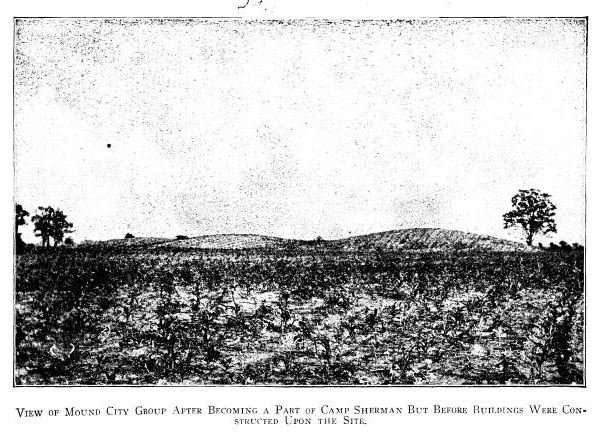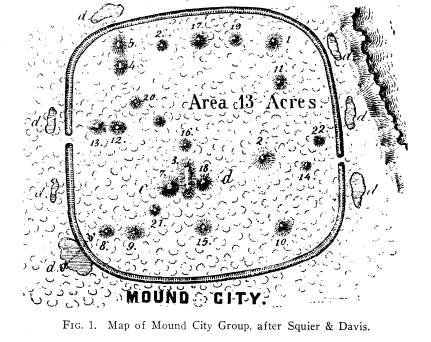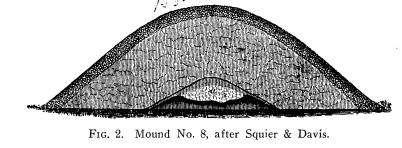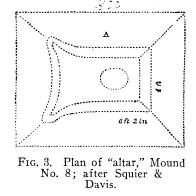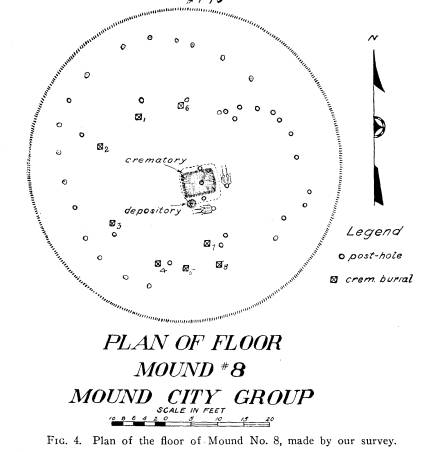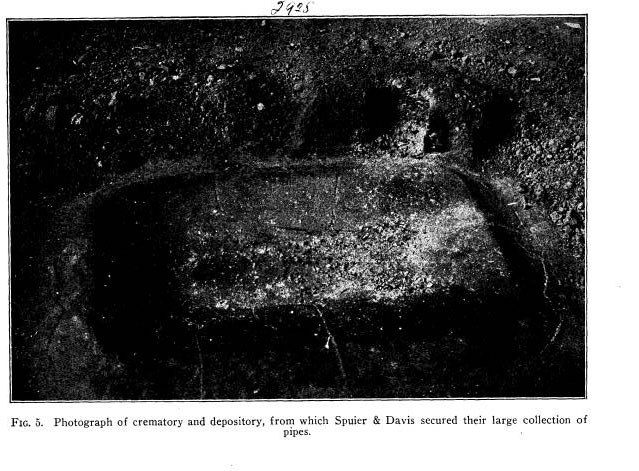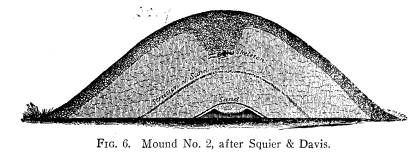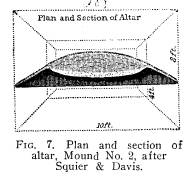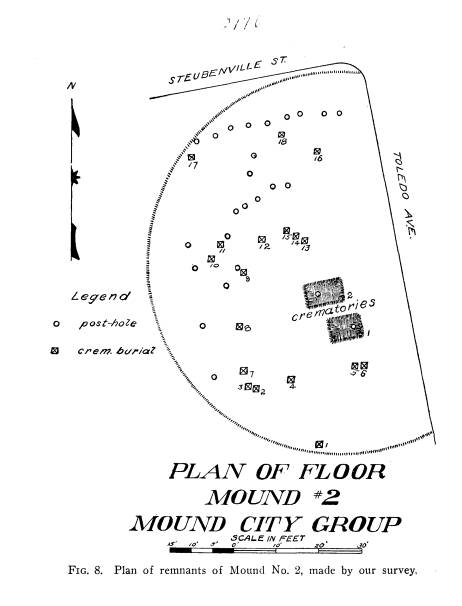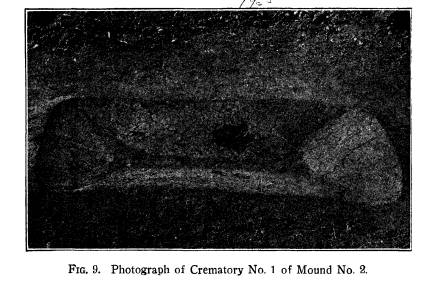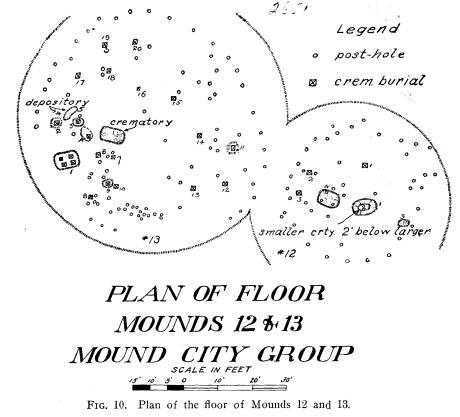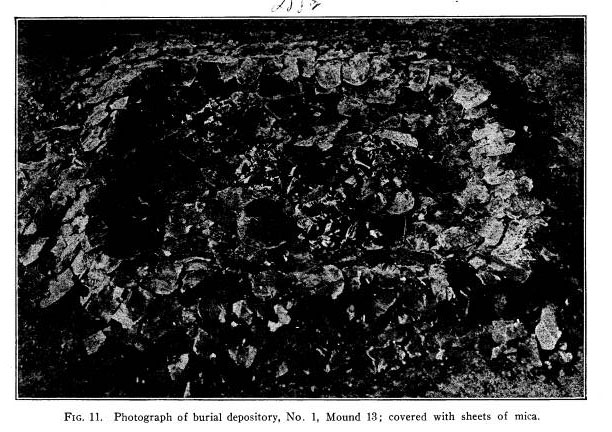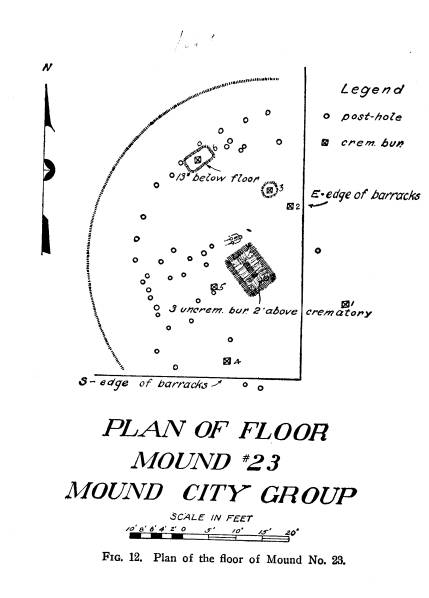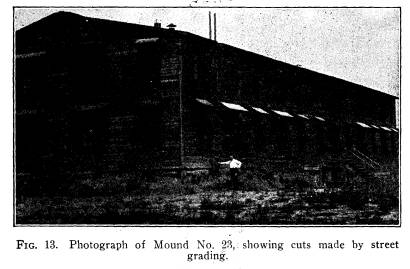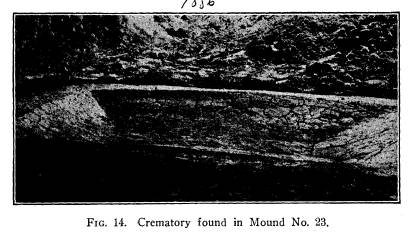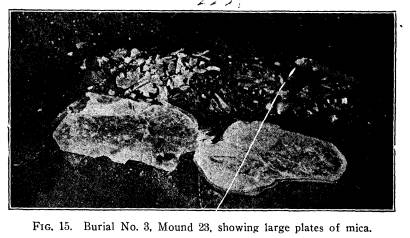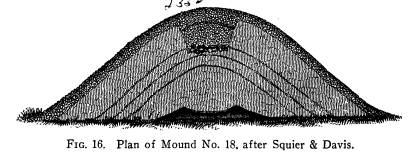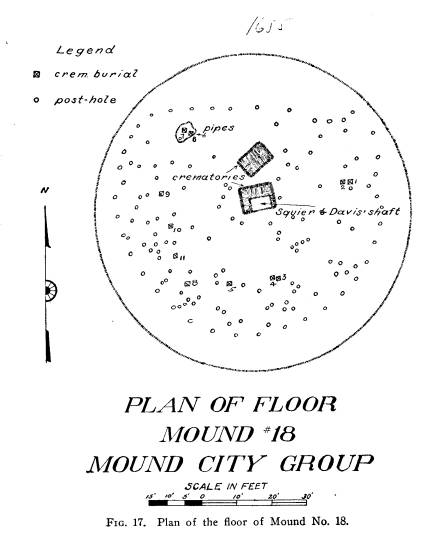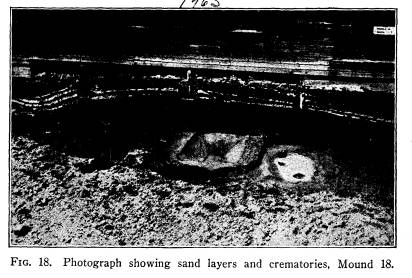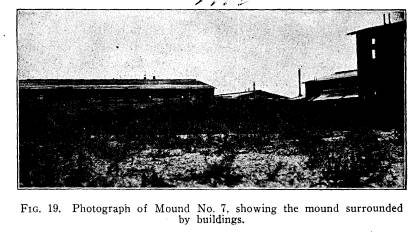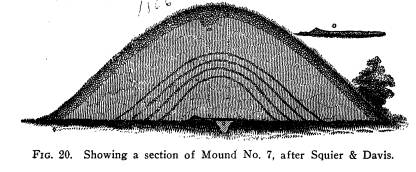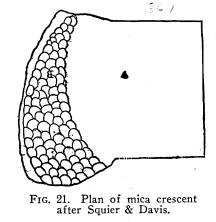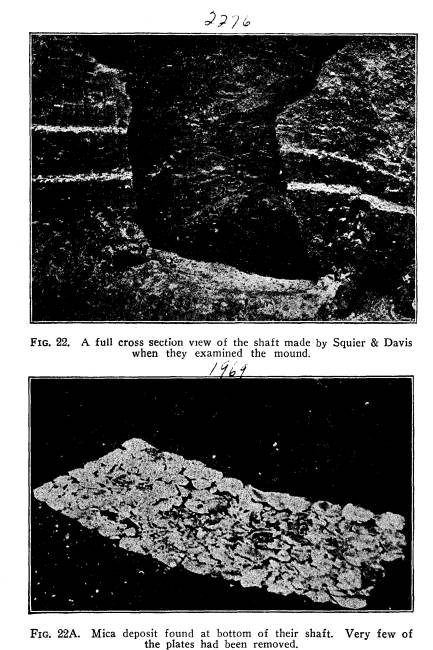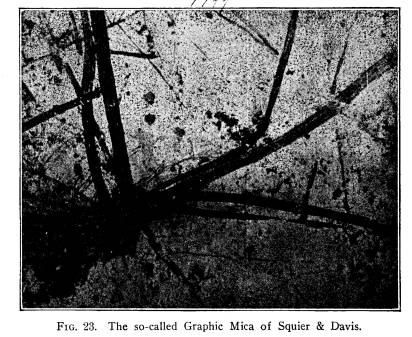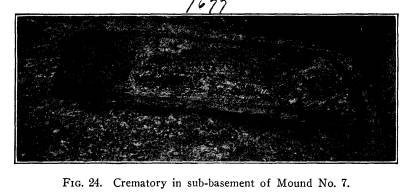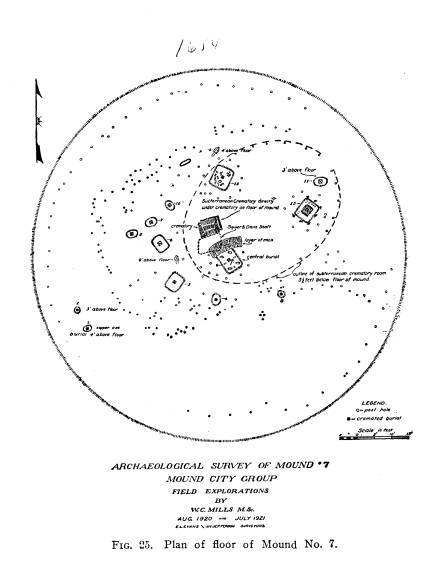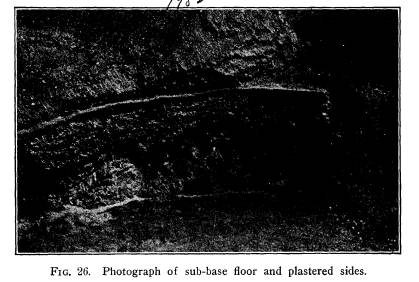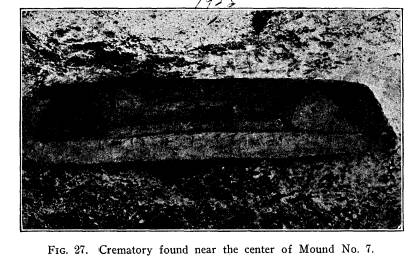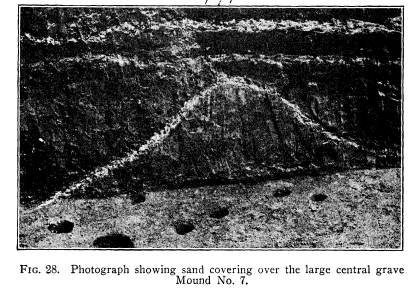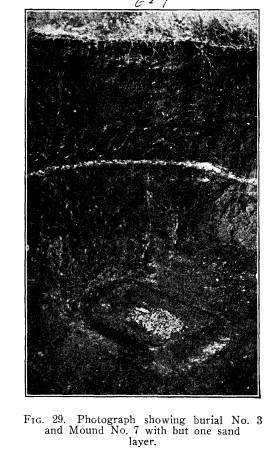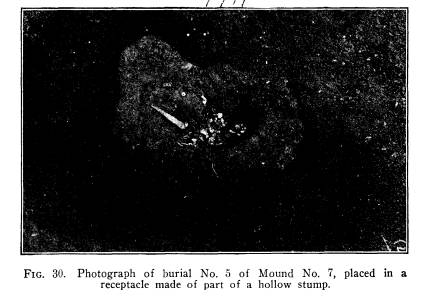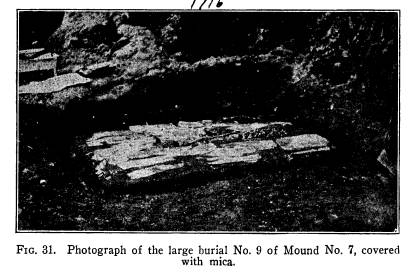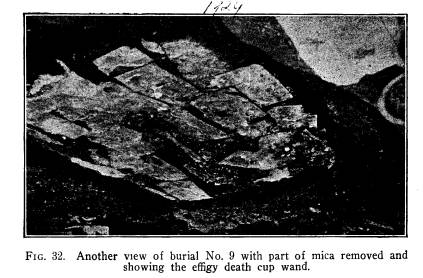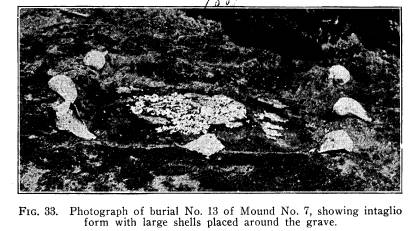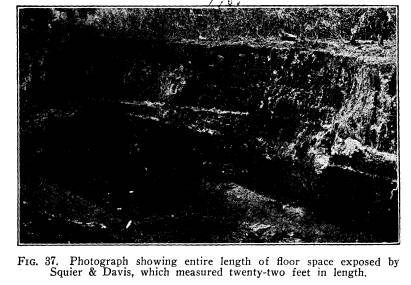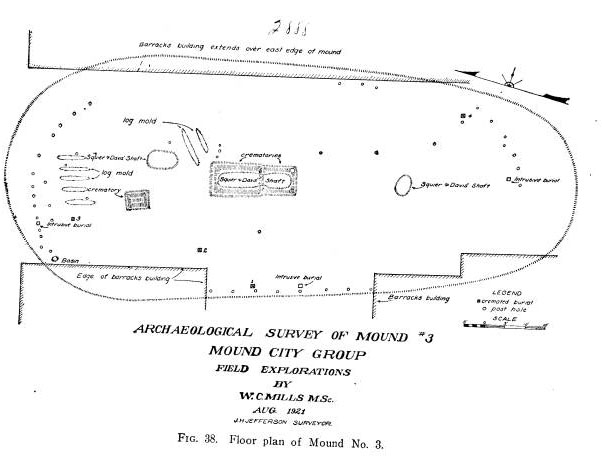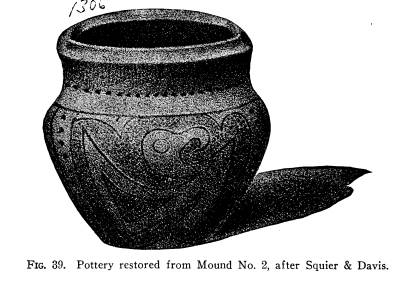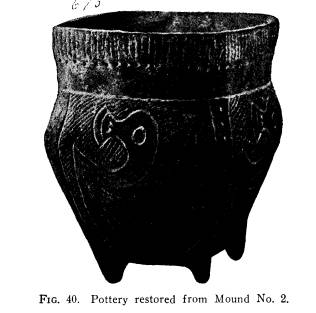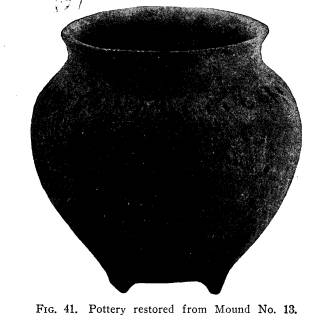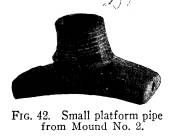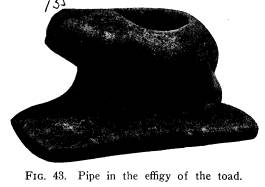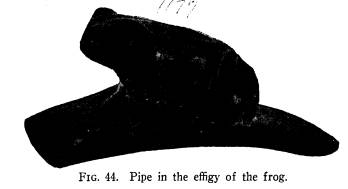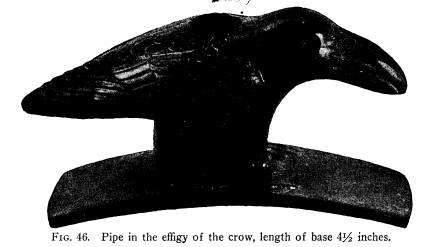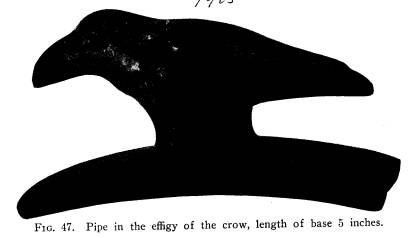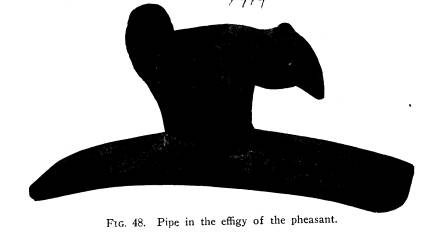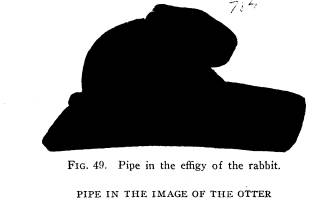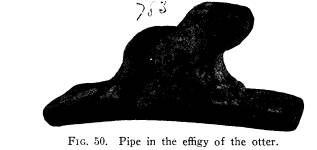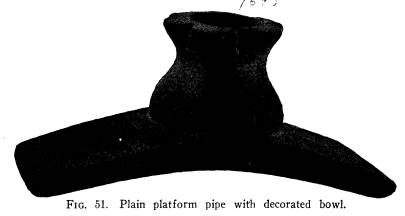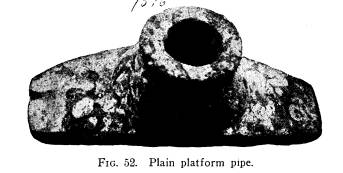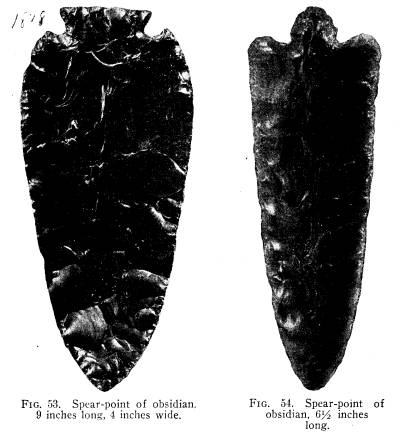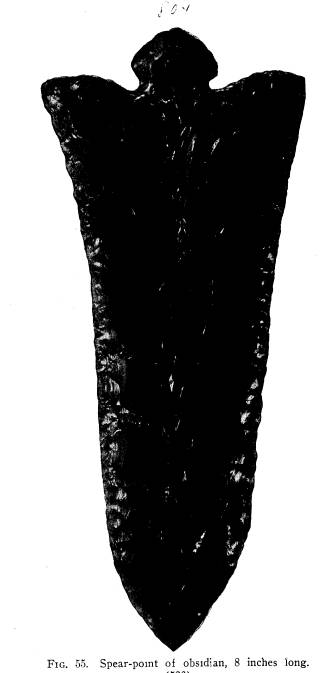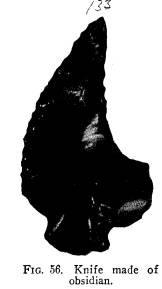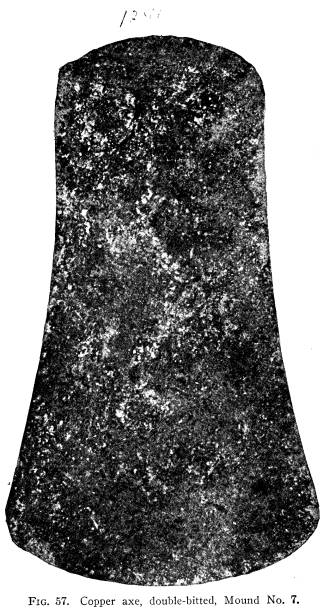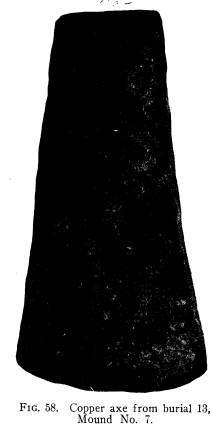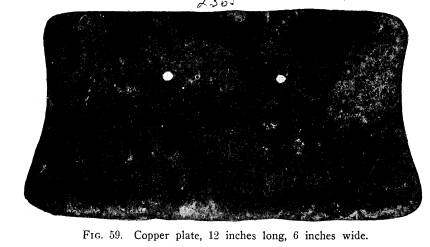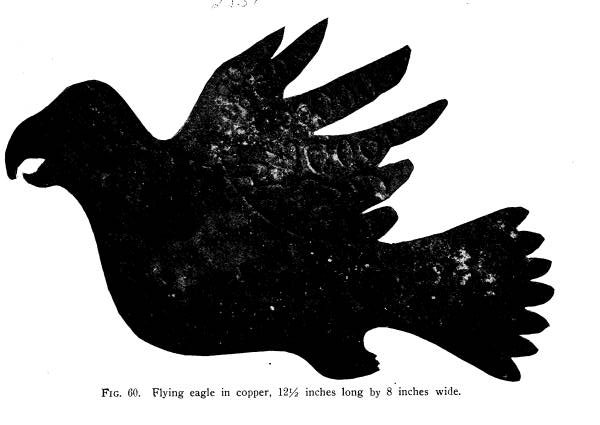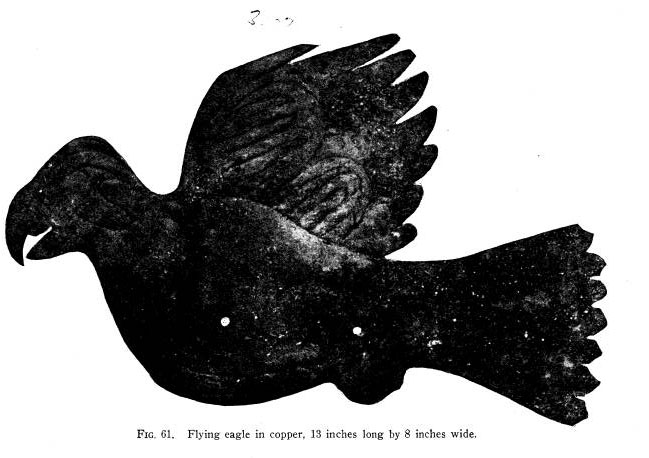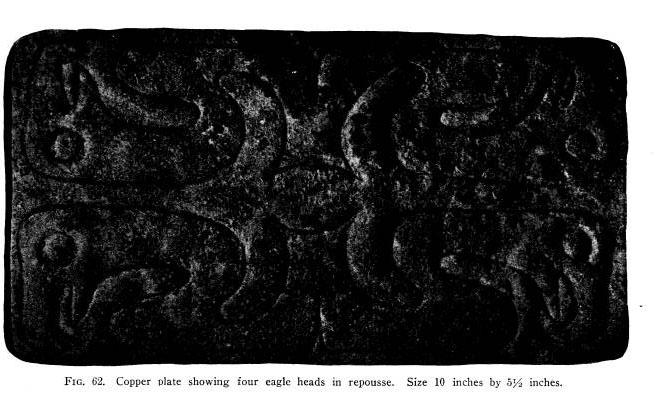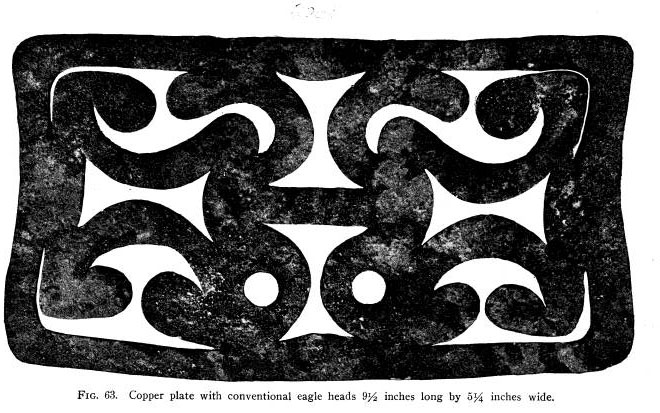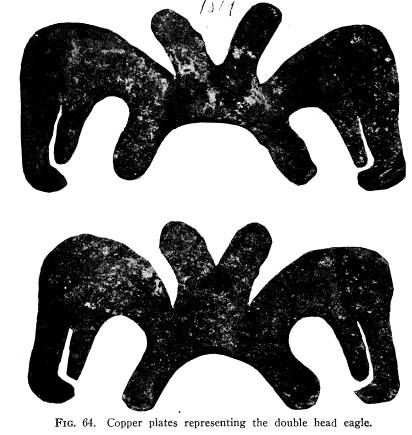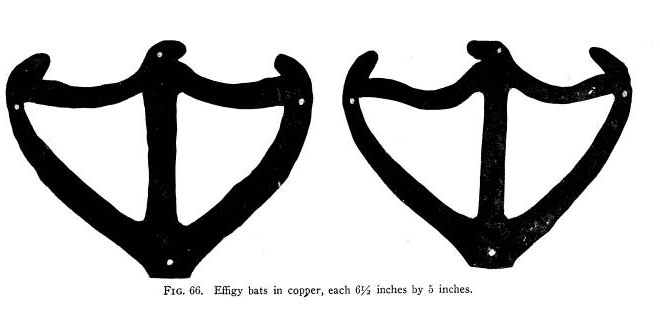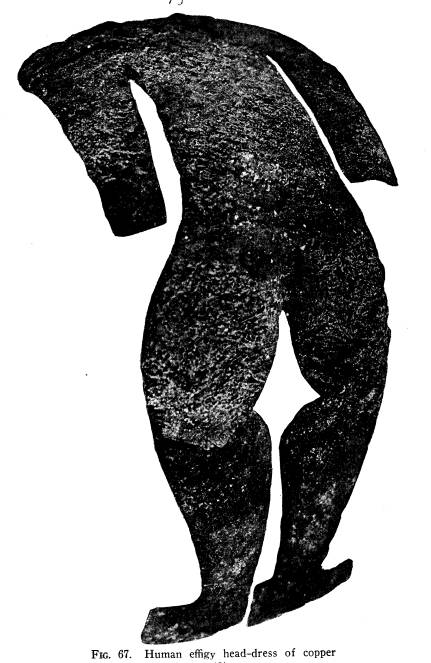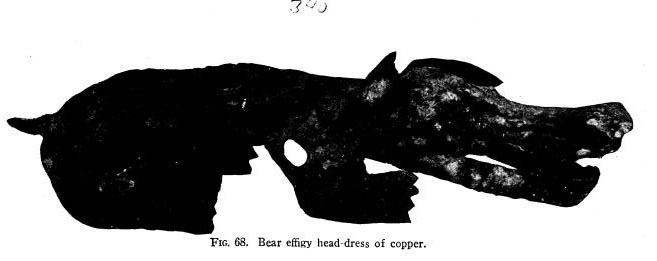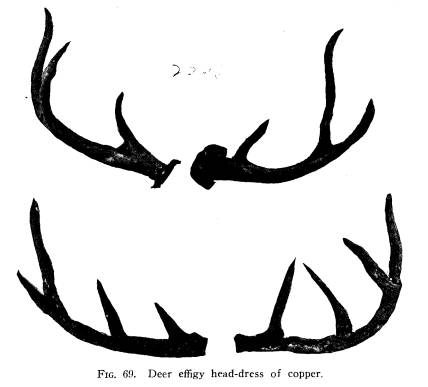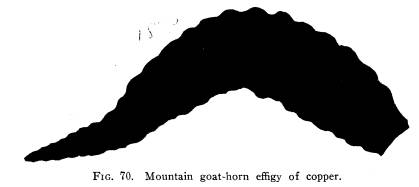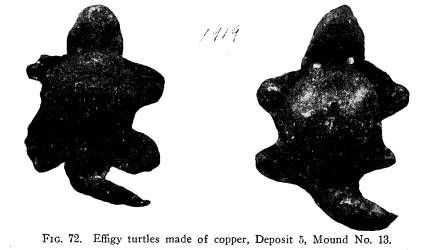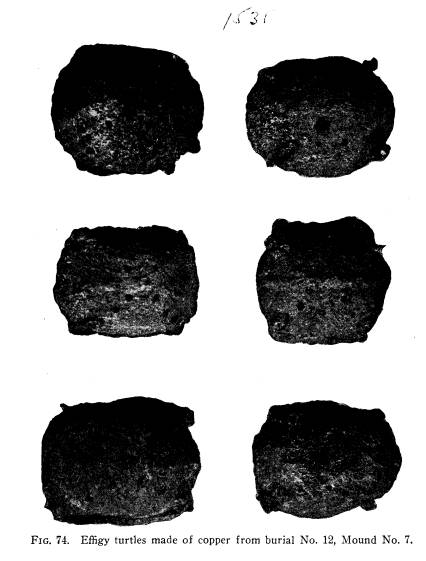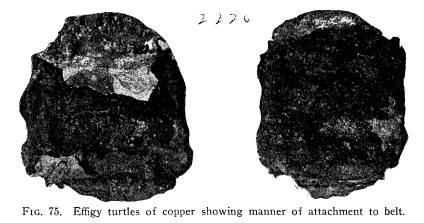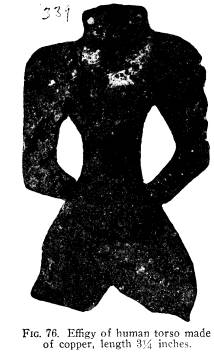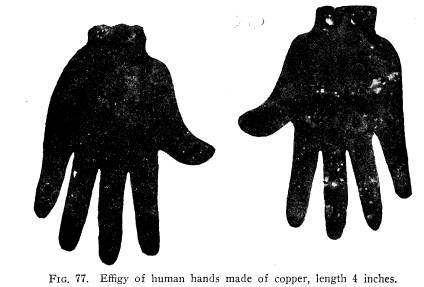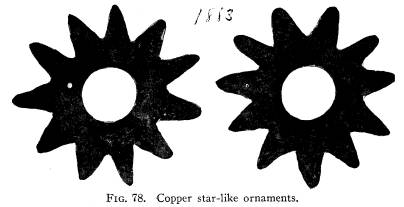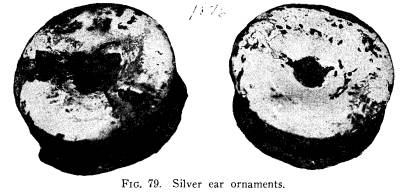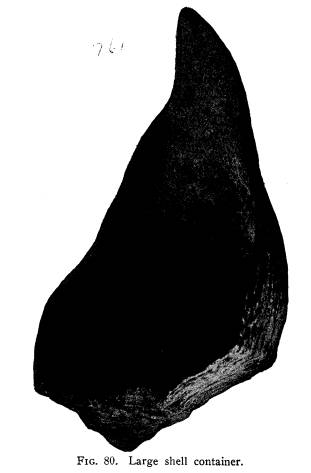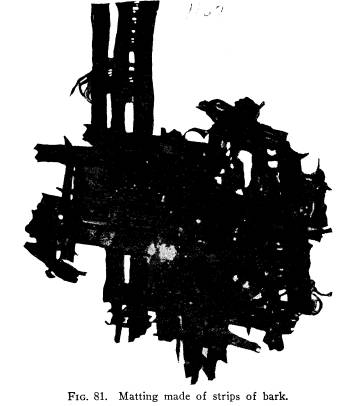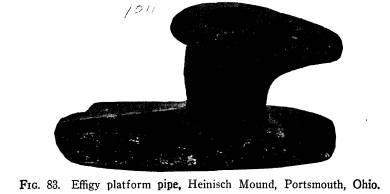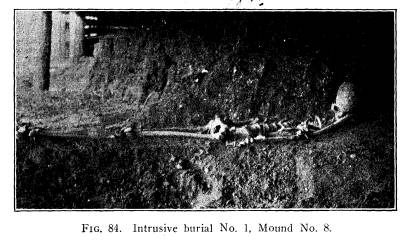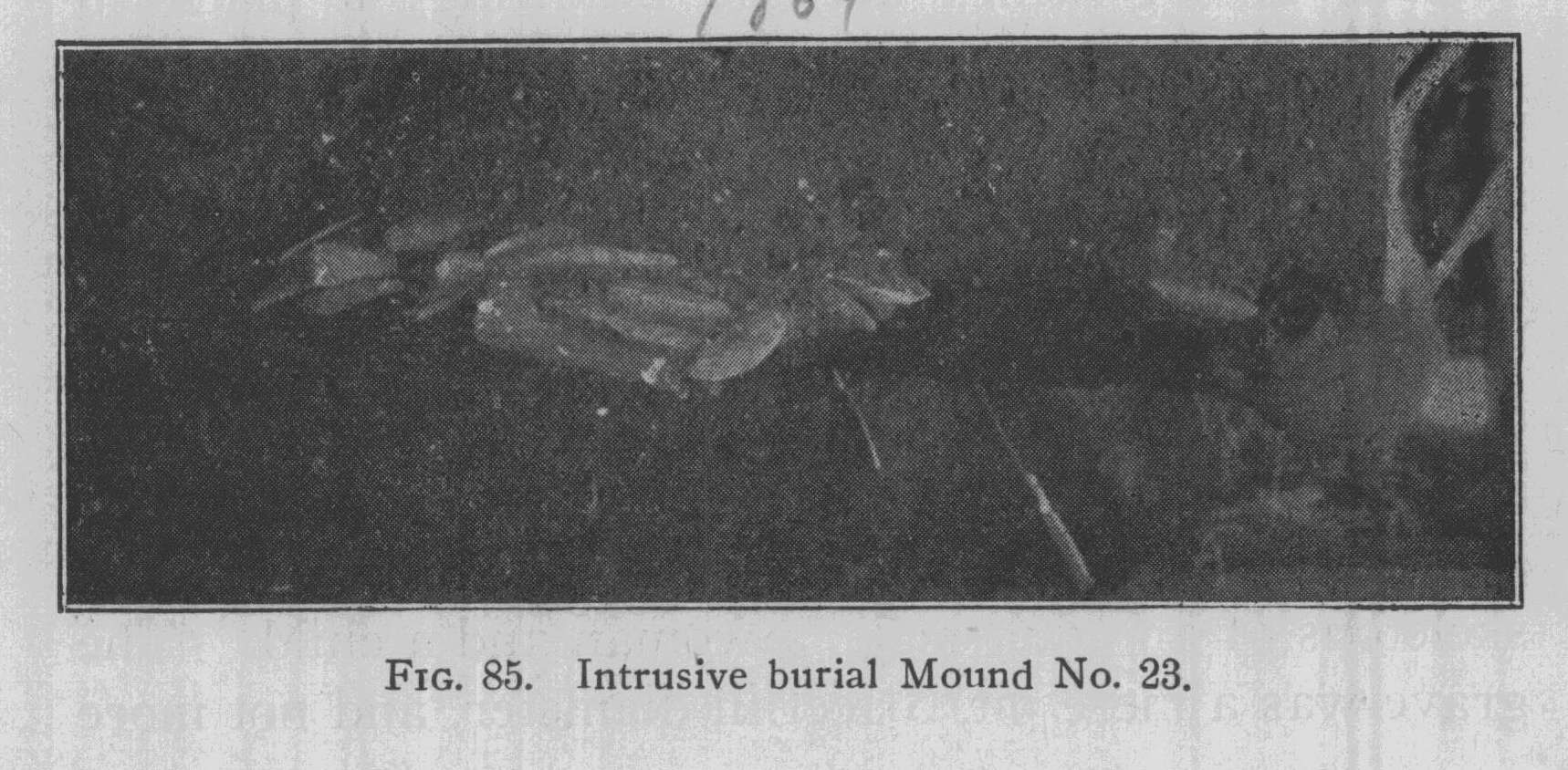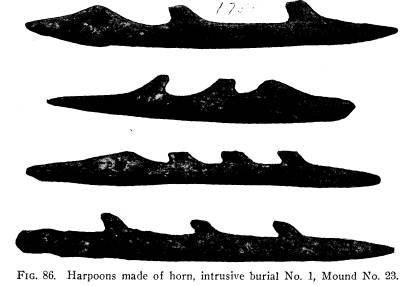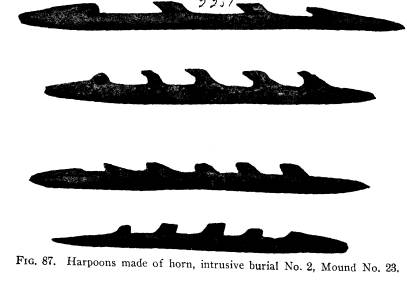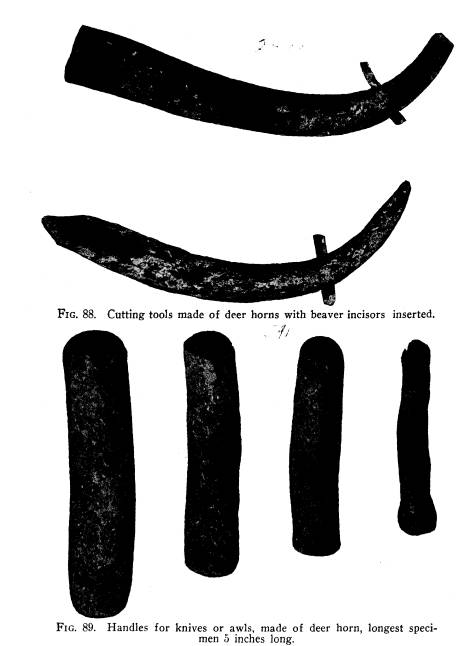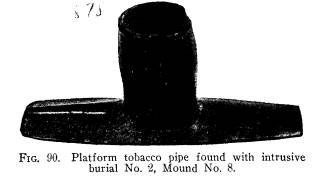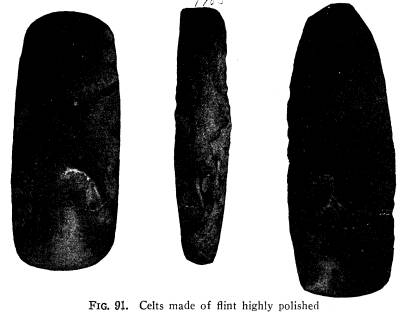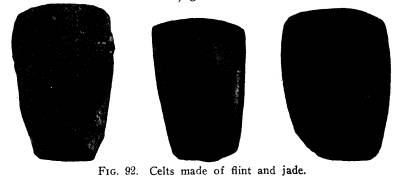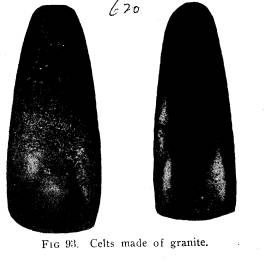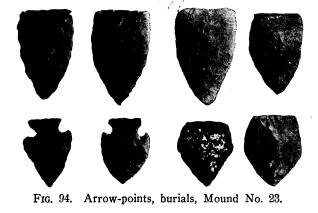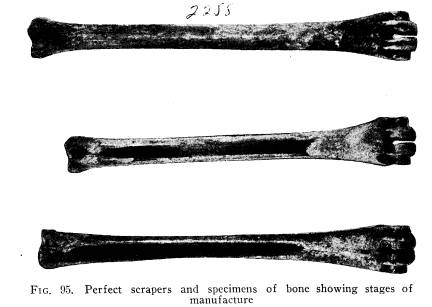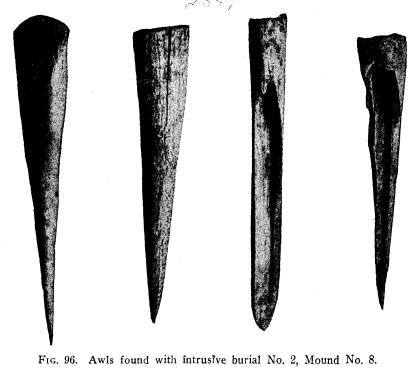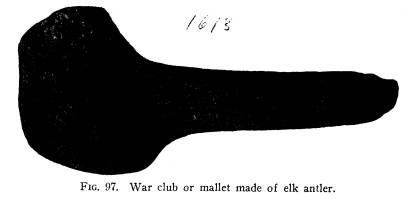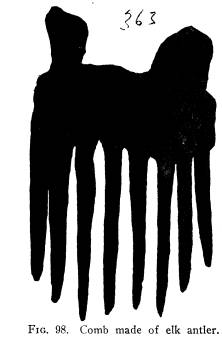Ohio History Journal
|
(422) |
EXPLORATION OF THE MOUND CITY GROUP
BY WILLIAM C. MILLS
INTRODUCTORY NOTE
Probably no other American prehistoric
earthwork
has excited so great a degree of
historic interest as the
so-called Mound City group of Ross
County, Ohio.
Certainly, from the prehistoric
viewpoint, it stands un-
surpassed.
Through the partial examination of the
group, in
1846, by Squier and Davis, and the
publication of the
report in Ancient Monuments of the
Mississippi Val-
ley, archaeological circles throughout the world have
been made acquainted with their
remarkable finds and
conclusions. So striking, indeed, were these results
and so wide-spread the circulation of
the report, pub-
lished by the Smithsonian Institution,
that Ancient
Monuments became, and has remained to many per-
sons, a classic contribution to
knowledge of the great
mound-building cultures of prehistoric
American peo-
ples. For many years the Mound City
group and its
contents continued to be considered as
the ne plus ultra
of Mound-builder achievement, and while
subsequent
explorers looked upon Squier and Davis'
accomplish-
ment as something to be striven for,
there was in many
quarters a feeling that the Mound City
"finds" would
never be equalled, much less
surpassed. This senti-
ment was voiced by no less a personage
than the late
Professor Frederick W. Putnam, dean of
American
(423)
424
Ohio Arch. and Hist. Society Publications
archaeologists when, in a conversation
regarding archae-
ological exploration in Ohio, he
declared to the writer
that, in his opinion, the Mound City
finds would con-
tinue to stand as unique. A few years
later, at the
very time when this Society's survey
was removing
from the Tremper mound, in Scioto
County, a collection
of specimens which not only duplicated
the finest arti-
facts taken from the Mound City group,
but actually
excelled them both as to quality and
numbers, work was
brought to a halt momentarily by the
arrival of a tele-
gram. This telegram brought the sad
news of Profes-
sor Putnam's death. That he did not live to learn of
the Tremper find which, even in his
great optimism, he
was unable to foresee, will always
remain a matter of
regret to the writer. The possibilities
of archaeological
research in Ohio had been
under-estimated.
The rich finds of the Tremper mound
naturally were
most gratifying, particularly as the
Mound City speci-
mens had been taken out of this
country, their loss to be
felt keenly by a later and more
appreciative public. But
the exploration of the Tremper mound
furnished some-
thing more than replacement of the loss
of the finest
examples of Mound-builders' art
discovered up to that
time. It furnished ideas and
information which, added
to the knowledge already accumulated
through earlier
recent exploration, could be brought
intelligibly and
logically to bear upon the deductions
and conclusions
of Squier and Davis with regard to the
Mound City
earthworks. The Tremper mound, as judged by its
exploration, and comparison with Squier
and Davis'
report, was analogous in all its
important aspects with
the great Ross County group, and it was
felt that a
complete examination of the latter
would furnish evi-
Exploration of the Mound City
Group 425
dence justifying the same or similar
explanation as to
its construction, purposes and usage.
Squier and Davis, it must be
remembered, worked
as pioneers. There were available to
them no data on
which to base an interpretation of
evidences appearing
to them in the Ross County group. It
was but natural,
perhaps, that some of these
interpretations should be
subjected to question after prolonged
explorations had
furnished firmer bases of fact. The more important
of these conclusions were their
conviction that the
builders of the Mound City group
practiced human
sacrifice; that, from this practice,
they should be in
some way rather directly related to the
dominant cul-
tures in Mexico and Central America;
that certain
basin-like receptacles constructed upon
the floors of the
mounds were the "altars" on
which human sacrifices
were made; and various minor
impressions, such as
their belief that the so-called
stratified mounds were
not used as places of burial.
Although Squier and Davis explicitly
state in their
report that their explorations
comprised all of the 24
or more mounds of the Mound City group;
and al-
though the work of constructing the
great military en-
campment at Camp Sherman, where the
group is
located, had obliterated all trace of
at least one-half of
this original number of mounds, our
survey, in the
spring of 1920, undertook the final and
complete exami-
nation of what remained, feeling that
even this remnant
still represented one of the more
important of Ohio's
prehistoric earthworks, not alone of
interest as a monu-
ment of our pre-Columbian predecessors,
but as of his-
toric import as well. The results of this examination
are set forth in the pages which follow.
426
Ohio Arch. and Hist. Society Publicatians
The writer is deeply indebted to the
War Depart-
ment for permission to carry on the
explorations within
Camp Sherman, and particularly to
General S. D.
Sturgis and the various officers
stationed at Camp Sher-
man for helpful cooperation and
personal interest in
the work; to many citizens of Ross
County and Chilli-
cothe, especially Mr. Albert C.
Spetnagel, Mr. Charles
M. Haynes and Mr. Frank Grubb, for personal
interest
and assistance at all times. To my staff of explorers
and engineers, particularly to Mr. H.
C. Shetrone, I am
under many obligations for their
untiring efforts
throughout the two seasons devoted to
the examination
of the group.
THE MOUND CITY GROUP OF EARTHWORKS
SQUIER AND DAVIS' MAP AND DESCRIPTION
The map of the Mound City group, from
the survey
of Squier and Davis at the time of the
explorations
therein, is here reproduced, as Fig. 1.
Their summary description of the group,
from
"Ancient Monuments of the
Missisisppi Valley"
(Smithsonian Institution, 1848) is as
follows:
"Situated on the left bank of the
Scioto River, four miles
north of the town of Chillicothe. The
enclosure, designated
from the great number of mounds within
its walls, 'Mound
City,' is in many respects the most
remarkable in the Scioto
Valley. Through the generous kindness
of Henry Shriver, Esq.,
upon whose estate it is situated, the
mounds were all permitted
to be investigated; and the work will,
in consequence, be often
referred to in the course of this
volume, particularly when we
come to speak of 'mounds.'
"In outline it is nearly square,
with rounded angles, and
consists of a simple embankment,
between three and four feet
high, unaccompanied by a ditch. Its
site is the beautiful level of
the second terrace, and it is still
covered with the primitive
forest.
|
Exploration of the Mound City Group 427 "The first and most striking feature in connection with this work is the unusual number of mounds which it contains. There are no less than twenty-four within its walls. All of these, as above observed, have been excavated, and the principal ones found to contain altars and other remains, which put it beyond question that they were places of sacrifice, or of superstitious origin. |
|
|
|
"These mounds seem placed generally without design in respect to each other, although there is a manifest dependence between those composing the central group, and between those numbered 4 and 5 and 12 and 13. From the principal mound numbered 7 in the plan, after the fall of the leaves, a full view of every part of the work and of its enclosed mounds is com- manded. This mound is seventeen feet high with a broad base nearly one hundred feet in diameter. The long mound, No. 3, is one hundred and forty feet long by eighty wide at the base, and ten feet in average height. Broad and deep pits, from which the earth for the construction of the mounds was taken, sur- round the work." |
428
Ohio Arch. and Hist. Society Publications
RECENT ASPECT OF THE GROUP
At the time of the final exploration of
Mound City,
described in this report, the entire
site was occupied by
the United States army cantonment, Camp
Sherman.
Incident to the construction of this
great camp, the
grading of streets and drilling-grounds
and the erection
of barracks and other buildings
resulted in unavoidable
disturbance of the group. In a number of instances
mounds were completely removed, the earth
composing
them being used for grading and
filling, and any speci-
mens they may have contained were thus
lost or scat-
tered among workmen. Others of the mounds fared
less disastrously, being disturbed in
part only, while
one, at least- the great central mound
of the group -
suffered no damage whatever.
Of the total of 24 mounds recorded by
Squier and
Davis, in the above description, only
12 - one-half the
original number- could be located or
identified by the
present survey. Several of the smaller of these, it is
known, had completely disappeared under
many years
of cultivation of the land, while the
remainder had
been obliterated in the construction of
the cantonment.
What these mounds may have contained in
the way of
material evidence of their builders
will never be known,
and the only record of their existence
is that of Squier
and Davis. Mounds of which no trace remained are
those numbered on their map as
follows: 1, 4, 5, 6, 10,
11, 14, 16, 19, 20, 21 and 22.
The condition of the mounds remaining
for final
exploration was as follows: Mound number 2, prac-
tically one-half entirely obliterated,
the remaining por-
tion being graded off to within 6
inches of its base;
Exploration of the Mound City
Group 429
mound number 3, the elongate mound of
the central
unit, disturbed by extensive
ramifications of camp
plumbing system; mound number 7,
intact, its removal
having been forestalled by special
intervention of the
camp commander, at the solicitation of
the Museum
authorities; mound number 8, one-third
graded off, to
within a few inches of the base; mounds
numbers 9 and
12, much disturbed by trenching for
plumbing system;
mound number 13, a part of one side
graded off, dis-
turbing the most important burial
thereof; mounds
numbers 15 and 17, very small
structures, more or less
disturbed by grading; mound number 18,
about one-
half graded down, but a considerable
depth of soil left
above the base; mound number 21, very
low, slightly
disturbed; and mound number 23, fully
two-thirds re-
moved, with no trace of floor
remaining.
The mounds of the group which remained
available
for exploration were examined, not
according to the
numbers given them by Squier and Davis,
but in tbe
order suggested by convenience and
conditions existing
in the camp. Naturally, those mounds
which had been
partly demolished, particularly those
having but a few
inches of earth above their floors and
thus more likely
to be disturbed by curious persons,
were examined with-
out delay. Several others, which in part or entirely
lay beneath barracks buildings, were
left until, late in
the autumn of 1921, the structures
interfering with
their examination were razed. It is
interesting to note
that in several mounds, notably numbers
8 and 13,
where portions of the bases had been
almost or quite
exposed by grading, numerous specimens
lay exposed
to view, and although many persons
constantly passed
these sites, the objects escaped
notice.
|
430 Ohio Arch. and Hist. Society Publications EXAMINATION OF MOUND NUMBER 8 The incentive for beginning the present exploration of the Mound City group with mound number 8 was two-fold. In the first place, as noted above, a portion of the mound had been removed to within a few inches of the base, leaving at least one burial partly exposed and various artifacts within reach of the curious. Sec- ondly, it was from this mound that Squier and Davis secured their noteworthy find of effigy pipes, upwards of 200 in number, and in connection with which they arrived at certain conclusions at seeming variance with later and more complete evidence in the same direction. The report of Squier and Davis on mound number 8 follows: "Fig. 37 (reproduced in Fig. 2) is a section of mound No. 8 in 'Mound City.' In the number and value of its relics, this mound far exceeds any hitherto explored. It is small in size, and in its structure exhibits nothing remarkable. It had but one sand stratum, the edges of which rested on the outer slopes of the altar, as shown in the section (Fig. 2). Between this |
|
|
|
stratum and the deposit in the basin occurred a layer a few inches thick, of burned loam. The altar itself, Fig. 38 (repro- duced as Fig. 3) was somewhat singular, though quite regular in shape. In length it was six feet two inches, in width four feet. At the point indicated in the section was a depression of perhaps six inches below the general level of the basin." |
|
|
|
small bird in its talons, which it tears with its beak. The panther, the bear, the wolf, the beaver, the otter, the squirrel, the raccoon, the hawk, the heron, crow, swallow, buzzard, paroquet, toucan, and other indigenous and southern birds, - the turtle, the frog, toad, rattlesnake, etc., are recognized at first glance. But the most interesting and valuable in the list, are a number of sculp- tured human heads, no doubt faithfully representing the pre- dominant physical features of the ancient people by whom they were made. We have this assurance in the minute accuracy of the other sculptures of the same date." The great importance of mound number 8 will be evident to all who read the above report, as will also |
432
Ohio Arch. and Hist. Society Publications
the intense interest with which our
later survey pro-
ceeded once more to uncover its mystic
interior. The
sentiment of members of the survey was
that of tread-
ing upon hallowed ground; for here was
a spot not
only of widely known pre-historic
importance, but, as a
result of the activities of two noted
pioneer explorers,
of marked historic importance as well.
It was, indeed,
with feelings befitting the occasion that
the present
survey presumed to lay bare the stage
where, more than
three-quarters of a century ago, Squier
and Davis' ex-
plorations revealed to the
archaeological world what has
continued perhaps to be the most widely
known tumulus
of the great mound-building cultures of
the Ohio valley.
While certain details of Squier and
Davis' conclu-
sions regarding mound number 8, its
purposes and
usages, seemed somewhat at variance
with the cumula-
tive evidence for the culture group as
a whole, there
was no predisposition to doubt the
correctness of their
observations, or rather the honesty of
their deductions.
At the time of their examination of the
group, there
were available almost no data on which
they might base
conclusions. It was felt, furthermore, that since their
explorations of the several mounds of
the Mound City
group were but partial, as a rule
simply covering the
immediate centers of the mounds, that
additional in-
formation was to be had through
exhaustive examina-
tion.
This information naturally would supplement,
and might either confirm or modify,
their original find-
ings. Furthermore, it was hoped that
the great central
basin and its immediate surroundings
would be found
intact, and that, less its content of
artifacts, of course,
the present survey might see and
examine it just as did
its original explorers.
Exploration of the Mound City
Group 433
BURIALS IN MOUND NUMBER 8
Burial number 1, of this mound, lay to
the north-
west of its center, in that part of the
tumulus which
had been graded off incidental to camp
construction.
The grading process had left but an
inch or two of
earth covering the burial, and
subsequent rains had
exposed its contents plainly to
view. The grave, a
slight depression upon the floor,
contained the cremated
bones of one individual, with which
were 16 copper arti-
facts, consisting of breast-plates,
ear-ornaments and
pendants. These specimens were hammered and
doubled together with the idea of
destroying their in-
trinsic value - a proceeding customary where objects
were placed in open graves, the idea
being to preclude
the possibility of their being stolen
by derelict members
of the tribe for personal use. This
"killing" ceremony
seems to have been widespread, and
aside from the
practical purpose served, may have carried
with it some-
thing of the idea contained in the
cremation ritual-
the release of the spiritual essence of
the object. In
the instance of incombustible
artifacts, the breaking
or mutilating of the object may have
served as did
cremation with those which were
combustible. That
this procedure was anything more than a
common sense
precaution, however, is not indicated
definitely, for in
the more pretentious burials of the
mounds of this
group, where the cremated remains
immediately were
covered by a primary protecting mound,
artifacts as
a rule were deposited entire. The only definite infer-
ence to be drawn is that broken and
mutilated artifacts
placed with the dead served equally
well the purpose of
perfect specimens.
Vol. XXXI-28.
434
Ohio Arch. and Hist. Society Publications
Burial number 2 lay to the southwest of
center,
occupying a basin-like depression in
the floor, one foot
deep.
With the cremated remains were found three
imitation eagle claws, made of copper;
a long slender
awl of copper; several large shell
disks, perforated;
many small shell disks; beads of shell
and pearl; about
100 perforated canine teeth of the elk;
several imitation
elk teeth; perforated bear canines; and
imitation
canines of the bear and the mountain
lion.
Grave number 3 was similar in
construction to
number 2. It contained the cremated remains of one
individual, with which were placed
several flake knives
and the flint core from which they were
chipped; two
slate gorgets, one perforated;
fragments of pottery-
ware; a number of perforated elk
canines; five copper
beads; and a necklace of claw-bones of
the bear and the
gray wolf.
Burials 5, 7 and 8 all lay toward the
south side of
the mound, were deposited upon the
floor without
special preparation, and contained no
artifacts.
Burial number 6 was placed directly
north of the
center of the mound, in a small
basin-like receptacle
on the floor. With the cremated remains
was a copper
plate, 6 inches long and 31/2 inches
wide. This plate was
extremely thin and fragile, and was
removed in frag-
ments.
THE CENTRAL DEPOSIT
Attention is directed to Fig. 4, in
which is shown
a plan of the floor of mound number
8. Besides the
burials above enumerated, and the
post-molds outlining
the circumference of the pre-structure
of the site, there
will be noted the great central basin
from which Squier
|
Exploration of the Mound City Group 435 and Davis report taking their remarkable find of effigy pipes and other artifacts. Contiguous to this basin there will be noted two skeletons, constituting uncre- |
|
|
|
mated intrusive burials, to be commented upon later in this report. The dotted line surrounding the main basin shows the extent of Squier and Davis' excavation in this mound - an area approximately 8 feet square. The |
436
Ohio Arch. and Hist. Society Publications
dimensions of the basin as given by
Squier and Davis
were found to be essentially correct,
although their out-
line drawing showing its form (Fig. 3)
is somewhat
misleading. Instead of being a peculiarly exact geo-
metric figure, the basin was found to
be of the usual
rectangular pattern in which the angles
of the corners
at its east end, instead of being
sharply defined, were
smoothed and rounded depressions.
In two respects the report of Squier
and Davis
regarding the deposit in this mound is
misleading. The
reader gets the impression, first, that
the entire deposit
of pipes, copper and other objects and
ashes, represent-
ing presumably a sacrifice, was found
within the basin
proper, or, as they term it, the altar;
second, that this
great deposit had been burned in place,
where found,
the heat having been sufficiently
strong to melt copper,
"masses of which were found fused
together in the
center of the basin."
As to the first of these suggestions,
it will be noted
by reference to the floor plan of the
mound, Fig. 4, and
to the photograph of the basin, Fig. 5,
that the present
survey found, at the southwest corner
of the "altar",
and entirely outside of it, a distinct
receptacle or de-
pository, not mentioned by Squier and
Davis. This
depository was in the form of an
upright mold, rounded
horizontally, and extending vertically
from the floor of
the mound to the height of 20
inches. The diameter
of this mold at the bottom was 18
inches, with a gradual
lessening toward its top. In a word, this mold was
exactly that which would result from a
filled bag being
set upright on the floor and covered
over with earth, the
bag and contents later being removed
and the arched
earth retaining its form and imprint.
|
(437) |
438
Ohio Arch. and Hist. Society Publications
It will be noted that the dotted line
of the floor plan
shows that Squier and Davis' excavation
intersected
this mold, disclosing its contents and
permitting their
removal, but left intact, in the body
of the mound, the
greater part of the opening. However, sufficient of
the original contents remained to show
their character.
More than 50 fragments of pipes, many
beads of pearl
and shell and a number of crystals of
galena were taken
from the bottom and around the edges of
this mold,
none of which showed contact with
fire. However,
associated with these objects were
several fragments of
a mineral, resembling copper, which
unmistakably had
been fused. Tests, however, showed this mineral to
be a copper arsenide, probably
whitneyite,* a product
of the Michigan copper region. The same mineral, in
large pieces, was found in mound number
13, where it
was associated with galena.
In view of the fact that the
rectangular basins,
termed by Squier and Davis
"altars", but now generally
recognized as crematories, were seldom
used as de-
positories of burials or artifacts; and
since such de-
posits often were made alongside and
quite near to the
basins, as in the Tremper mound, and in
mounds 13
and 7 of the Mound City group, the
evidence for mound
number 8 is that the great find of
pipes and doubtless
many others of the accompanying
specimens were taken
from this supplemental depository, and
not from the
central basin.
*Samples of the fused metal from the
deposit were submitted to
Professor William J. McGaughey of the
department of mineralogy, Ohio
State University, for
identification. They were found to be
whitneyite or
closely allied copper arsenide mineral.
Exploration of the Mound City
Group 439
THE SO-CALLED ALTAR
Consideration of the basin itself
strengthens this
idea, and brings us to the second
supposition of Squier
and Davis - namely, that an extensive
cremation had
beer effected on the "altar",
the heat from which was
so intense as to fuse the accompanying
artifacts of cop-
per. In the "altar", or
crematory, as in the case of the
supplementary depository, it was
fortunate that no
mutilation had resulted from former examination. As
with other mounds of the group, the
excavation had
been immediately filled, in accordance
with require-
ments of the owner of the land, thus
enabling our sur-
vey to view in a very satisfactory
manner those por-
tions of the floor uncovered by the
early explorers.
The crematory basin was found to be
devoid of con-
tents, with the exception of a few
charred human bones
and a fragment of a copper object,
closely attached to
the floor of the basin through
corrosion, the original
mass of ashes and artifacts having been
removed, of
course, upon first examination. However, a glance at
the basin, once more exposed to view,
was sufficient to
show that the supposedly intense
sacrificial or crema-
torial fires of Squier and Davis never
had occurred
therein. As so often noted in the crematory basins of
other mounds of the group, this one had
undergone
extensive repairs. Continued use of these basins as
crematories, with alternate heat and
moisture, resulted
in all instances in damage in the way
of checking and
cracking. In this particular basin, this cracking had
been very pronounced, the separation
being as much as
one inch in width. These cracks, as
well as portions of
the floor which had been altogether broken
away, were
440
Ohio Arch. and Hist. Society Publications
neatly repaired by filling with puddled
clay, bluish-drab
in color. The fresh clay used in these
repairs was en-
tirely unburned, and showed no contact
whatever with
fire. In view of this fact, it becomes
clear that crema-
tion or burning of the deposit found in
this basin had
occurred elsewhere, possibly in the
adjoining mound,
number 9, which appears to have been
supplemental to
number 8 in purpose.
ULTIMATE CONCLUSIONS
The evidence, then, as to mound number
8 and its
central deposit, as interpreted by this
survey, is as fol-
lows:
After cremation elsewhere, probably in the ad-
jacent mound, number 9, the human
remains were
brought to mound number 8, and,
together with their
accompanying artifacts of copper and
other objects,
were deposited within the basin
formerly serving as a
crematory. In close proximity to this basin and its
contents, were then deposited the
pipes, beads, and so
forth, in their bag-like container,
while over this offer-
ing and the basin alike was heaped the
covering and
protecting mound of earth. The fact
that the bag con-
tainer was not destroyed in the burning
of the struc-
ture enclosing the site of the mound,
but retained its
form and position when the earth was
heaped over it,
indicates one of two things; either the
structure was
burned prior to the placing of the
deposit, or the fire
incident to the burning did not reach
and consume it.
The finding of the copper arsenide,
fused together
by heat, mingled with the unburned
fragments of pipes,
beads and so forth in the supplemental
depository,
shows unmistakably that the fusing and
burning had
been accomplished prior to the
depositing of the speci-
Exploration of the Mound City
Group 441
mens where found. The copper arsenide mineral,
covered with the carbonate of copper,
through prox-
imity and oxidation, might easily be
mistaken for cop-
per; hence it is apparent that the
fused copper reported
by Squier and Davis was in reality the
copper arsenide
or whitneyite. The fact that a degree
of heat in excess
of 2300 Fahrenheit is required to melt
copper makes it
improbable that the open fire of the
cremation ceremony
would result in fusing that metal, as
Squier and Davis
believed had been done; while the
copper arsenide, with
a melting point of approximately
one-fourth that of
copper, would readily be affected by
the degree of heat
generated in an ordinary open fire.
MOUND NUMBER 2
Formerly very large, mound number 2 had
been
seriously disturbed by the construction
of a thorough-
fare through Camp Sherman, the eastern
one-half be-
ing entirely obliterated, and the
remainder graded off
to within 6 inches of its base. This
remaining portion
of floor gave evidence of the
importance of the mound
as a whole, since it contained 18
burials and two crema-
tories. A large basin, or
"altar", as they termed it, is
described by Squier and Davis, which,
since its dimen-
sions do not correspond with either of
those found by
the present examination, must have been
located within
the eastern one-half of the mound. Their description
is as follows:
"Fig. 31 (reproduced in Fig. 6)
exhibits a section of mound
No. 2
in the plan of 'Mound City.' This mound is
ninety feet in
diameter at the base by seven and a half
feet high, being remark-
ably broad and flat. A shaft six feet
square was sunk from the
apex with the following results:
|
|
|
some fragments of pottery, also a few shell and pearl beads. Enough of the pottery was recovered to restore a beautiful vase, for a drawing and description of which the reader is re- ferred to the paragraphs on Pottery. The second or lower sand stratum in this, as in several other instances, rested directly upon the outer sides of the altar." The crematories located in the section of floor re- maining for final examination were smaller in every way than those above described. |
Exploration of the Mound City
Group 443
A plan of the remaining portion of the
floor of
mound number 2 is shown as Fig. 8. From
the scant
depth of undisturbed earth above this
floor, from 4 to 6
inches, it will be apparent that any
pretentious grave
of the platform type that may have
existed thereon
would have shared the fate of those
contained in the
portion entirely eradicated.
Examination of the floor remnant was
begun on the
south side, where but 4 inches of earth
remained. With
graves numbers 1, 2, 3 and 7, lying
toward the south,
no artifacts were found, the burials
consisting solely of
the usual charred bones placed upon the
floor without
preparation. Burial number 4 contained a necklace of
47 pearl beads, undamaged by fire and
fairly well pre-
served. Burials 5 and 6 were similar to
the first-named
and devoid of specimens.
Crematory number 1 lay about 10 feet to
the north
of the burials numbered 5 and 6, and is
shown as Fig.
9.
It measured 6 feet in length, 4 feet in width and
6 inches in depth. Ten fragments of
pottery-ware and
a small quantity of charred human bones
remained in
the basin from cremation. This crematory was well
made from puddled clay, and although
its surface was
much cracked it had never been mended.
Crematory number 2 (Fig. 8) was located
about 4
feet directly north of basin number 1.
It contained no
cremated remains, but a quantity of
broken pottery-
ware taken from it proved to be, upon
restoration, a
single vessel very similar in type and
decoration to a
vessel taken from this same mound by
Squier and Davis.
The vessel is described under the head
of pottery. It
will be noted that mound number 2
contained three
crematories - one found by Squier and
Davis and two
|
|
|
(444) |
|
Exploration of the Mound City Group 445 by the final survey. This is not unusual, since mounds numbers 12 and 21 each were found to contain a similar number of such basins. As the examination was carried through to the northward, burials 8 to 15 were disclosed. All were placed simply upon the well-defined floor, without arti- facts. Burial number 16, placed about 25 feet directly north of crematory number 2, was of especial interest, |
|
|
|
in that it contained a number of copper specimens. The cremated remains were placed upon two large plates of mica, laid flat upon the floor, and measuring 15 by 11 inches and 16 by 9 inches respectively, each 1/4 inch thick. These plates were cut into form and rounded at the ends. Upon them, and associated with the charred human remains, were ten copper pendants, up- wards of 6 inches in length, ovate in form with two perforations at the larger ends for attachment; 22 |
446 Ohio Arch.
and Hist. Society Publications
effigy teeth of the alligator, made of
copper; 12 copper
button-shaped objects, filled with
colored clay; 35 per-
forated canine teeth of the elk; 12
marine shells
(olivella) perforated for use as beads;
330 pearl and
shell beads, forming a large
necklace. Near the edge
of this burial was the point of a large
obsidian spear,
vertically placed, the base of which
had been broken
off and carried away by scrapers used in
razing the
mound.
Burial number 17 lay some distance to
the west of
number 16, and occupied a prepared
grave made by
excavating a basin in the floor to a
depth of 12 inches
and with a diameter of 18 inches. With the burial
were placed a number of thin sheets of
mica, several
barrel-shaped shell beads and a
miniature platform pipe,
quite similar in form to the larger
pipes found in other
mounds of the group. This pipe, less than 11/2 inches
in length, is unusual in having the
stem-hole drilled
partly in each end of the platform,
toward the bowl.
Burial number 18 was found near the
northern edge
of the mound, just within the line of
post-holes marking
the outer circumference of the
structure. It was placed
upon the floor and was accompanied by a
few shell
beads.
The destruction of mound number 2 as a
result
of grading operations for the camp is
most regrettable,
since several fine graves are reported
by the superin-
tendent in charge of the work at the
time to have been
destroyed, and a number of unusual
specimens appro-
priated by workmen and onlookers.
Exploration of the Mound City
Group 447
MOUND NUMBER 13
Squier and Davis make no mention of
having ex-
amined mound number 13, aside from
their general
statement that all the mounds of the
group were ex-
plored by their survey. The present
survey, however,
found no evidence of their work in this
mound, so
readily discernible in others of the
group in which they
had operated. The work of examining this mound,
which was approximately 70 feet in
diameter and 3
feet high, was greatly hampered by a
large barracks
building, which covered all excepting
its western mar-
gin. The clearance of the building
above the top of
the mound was but 6 inches, thus
affording a working
space of only 31/2 feet. The margin
extending beyond
the building had been graded away to
within a few
inches of the base line, while workmen,
for reasons un-
ascertained, had cut away a portion of
the mound ex-
tending from the outer edge of the
building to a point
several feet eastward, or beneath the
barracks, throw-
ing the earth outside. In so doing,
while the removal
of earth had not reached to the base of
the mound, a
grave or deposit of artifacts had been
disturbed, ob-
jects from which were found scattered
upon and
through the displaced earth just
outside the building.
Among these objects were copper
ear-ornaments, per-
forated and cut teeth, broken pipes,
plates of mica and,
lying upon the crest of the mound at
the top of the cut,
beneath the edge of the building, two
large copper
breast-plates, where apparently they
had been placed by
the workmen who uncovered them. The
only further
disturbance of the mound was that
incident to the set-
448
Ohio Arch. and Hist. Society Publications
ting of a large post, supporting the
building, at a point
near the center of the tumulus.
Examination was begun outside the
building where
the exposed margin had been partly
graded down, and
where the earth from beneath the
building had been
thrown. By the use of a large screen, many additional
specimens, including ornaments, beads,
broken pipes
and objects of copper, were secured
from this disturbed
earth.
THE GREAT MICA GRAVE
As the work of excavation neared the
edge of the
building, evidences of a grave became
apparent. This
proved to be a large and important
depository, lined
with sheets of mica and containing four
cremated
burials. The location of this
depository will be noted
in the floor plan of the mound, shown
in Fig. 10. The
dimensions of this peculiar receptacle,
which was rec-
tangular in form, were 7 feet long and
61/2 feet wide,
measuring from center to center of the
oval ridge form-
ing its sides and ends. The entire surface of the de-
pository, as well as the ridges forming
its circumfer-
ence, were covered with large sheets of
mica, in size
from 6 by 6 inches to 16 by 14 inches.
A photograph
of this multiple grave, or depository,
with its splendor
of mica, is shown in Fig. 11. Two of
the four burials
contained artifacts; with one was
placed a copper head-
shield, 11 inches in length, made to
fit the head helmet-
fashion, while another contained a
circular mica object,
one foot in diameter, presumably used
as a mirror.
The ridge forming the sides of this
depository were
found to be made up of earth filled
with carbonaceous
matter, and broken and perfect
artifacts. Among these
|
Exploration of the Mound City Group 449 latter were more than 100 pieces of pipes; many
pearl and shell beads; perforated animal canine teeth;
large quantities of galena crystals, aggregating more than
25 pounds in weight; large pieces of whitneyite,
weighing as much as three pounds each; perforated sharks'
teeth; |
|
|
|
awls of bone and of copper; and fragments of quartz and obsidian spear-points. Among the fragments of pipes and other broken objects, were found parts
repre- senting many entire objects and permitting of
numerous gratifying restorations. Vol. XXXI-29. |
Exploration of the Mound City
Group 451
This intentional mixing of artifacts
with the soil
used in constructing the grave, or
depository, is inter-
esting when compared with the
proceeding employed in
connection with another grave, soon to
be described, in
which the objects were broken and
placed as a deposit
alongside the burial.
The method of covering this pretentious
depository
with its four burials was most
striking. Inside a line
of posts, surrounding it, had been
heaped a small pri-
mary mound of clay, 2 feet in
height. Over the top
and along the north side of this small
mound had been
placed a layer of fine sand, and upon
this, in turn, a
covering of plates of mica. A similar sand covering
on the south side had slipped from
above to its base,
where it lay accumulated in a
ridge-like formation.
OTHER IMPORTANT GRAVES
Directly north of depository number 1,
at a distance
of 8 feet, lay burial number 2. This
was placed upon a
prepared grave, the incinerated remains
in its center
and artifacts surrounding them. These consisted of
two copper ear ornaments of the usual
pattern; a large
flint spear-point broken into several
pieces, and three
unusual and highly interesting copper
plates, cut in the
form of double-headed eagles.
Burial number 3 lay directly east of
number 2, and
occupied a raised platform extending
about one inch
above the floor. At its center were the cremated
remains and around them the following
objects: a large
obsidian spear-point, 9 inches long and
4 inches broad;
another obsidian spear, over 6 inches
in length; a flint
spear-point, 3 inches long; four copper
ear ornaments of
the usual type; six copper cone-like
beads; six copper
452
Ohio Arch. and Hist. Society Publications
tubular beads; five strips of copper,
several inches in
length, turned upon itself to form an
edge-binder for
fabric; a large copper head-dress made
to represent a
bear, and a small amount of woven
fabric, evidently a
part of the elaborate head-dress. The
copper head-
dress, representing the bear, is a
unique specimen, in
that the ears are ingeniously hinged to
permit move-
ment, while the legs are attached to
the body by means
of rivets.
Burial number 4, lying to the eastward,
between
numbers 1 and 3, was placed upon a low
platform ex-
tending about 1 inch above the floor.
The incinerated
remains were placed at one end of this
platform and
the accompanying artifacts at the
other. These com-
prised a large helmet-like head-dress
of copper, to-
gether with three sets of imitation
deer antlers of cop-
per; and two effigy human hands, of
copper, four inches
in length. The imitation antlers, doubtless a part of
the elaborate head-dress, were of three
distinct kinds.
One set, 9 inches long, were plain and
slightly curved,
without tines; a second set, about 6
inches in length, had
the characteristic curves of true
antlers, and each was
supplied with three tines; while a
third set, of about the
same size and curvature, had four
tines.
AN UNUSUAL DEPOSIT
The location designated as number 5, on
the floor
plan of mound number 13, was an unusual
form of
deposit, apparently having some
relation to burials 2
and 3. This deposit, consisting of a
mass of dark
earth intermixed with much carbonaceous
matter and
containing numerous artifacts, occupied
a space about 5
feet long, 2 feet wide and 12 inches
deep. Among the
Exploration of the Mound City
Group 453
objects taken from this deposit were
perforated teeth
of the shark, pearl, shell and bone
beads; effigy turtles
made of copper; small copper ornaments
in the form of
crosses; a curved knife of obsidian,
three inches in
length; large fragments of quartz and
obsidian spears;
effigy bear teeth; perforated canine
teeth of the elk; cut
shell ornaments; a large number of
broken pipes, both
plain and effigy types, a number of
which were restored;
and numerous fragments of pottery-ware,
from which
a fine vessel was pieced together.
Just west of this deposit, and directly
north of burial
number 2, was found an interesting
cache of beads.
This cache is a striking example of the
ingenuity and
perseverance of the inhabitants of the
Mound City
group, comprising, as it did, more than
5,000 excep-
tionally well formed and finely
finished specimens. The
beads are barrel-shaped, somewhat less
than one-half
inch in length, and are made from
columella of marine
shells. The material used, in many
instances, was of
extreme hardness, almost enamel-like in
character; and
in view of the difficulties it would
present to primitive
methods of workmanship, the unusually
large number
of beads, and the great care and
exactness with which
they were fashioned, it is apparent
that they represent
an exceptionally great amount of labor,
skill and
patience.
Although embedded in a mass of yellow
clay, the
beads comprising this deposit retained
a freshness and
whiteness unusual in bone objects found
in mound
burials, a condition which was not
without its explana-
tion; for it was plainly to be seen
that they had been
contained in a receptacle, probably a
buckskin bag, the
mold of which was preserved in the
covering of clay.
454
Ohio Arch. and Hist. Society Publications
A further feature of this deposit was
that before being
placed where found, it had been
subjected to the "kill-
ing" ceremony. This was effected
by placing the bag
of beads upon a hard surface, and
repeatedly striking
them with a stone hammer, the result
being that the
greater part of the contents were
crushed and broken.
The bag, with its contents was then
deposited where
found.
THE CREMATORY
The crematory of mound number 13 was
found di-
rectly east of burial number 4, [as
shown on the map of
the floor plan]. It had not been disturbed, and was
devoid of ashes or cremated remains.
The basin was
6 feet long, 4 feet and four inches
wide, and 6 inches
deep at the center. The construction of
this basin was
unusual, since, instead of the
customary flat bottom, the
sloping side-walls and ends were
carried inward and
downward until they converged, thus
resulting in a V-
shaped cross-section. The east end of the crematory
had been repaired with a light-colored
clay, resembling
fire-clay, the basin showing no
subsequent use for cre-
mation purposes. The west end of the
basin was coated
with a red pigment, doubtless used
incidental to crema-
tion ceremonies.
Burial number 6, with which were placed
a few
beads, and burial number 7, were
located directly south
of the crematory. Burials 8 and 10 lay just south of
burials 6 and 7, were devoid of
artifacts, and were
placed simply and without preparation
on the floor.
Burial number 9 occupied a basin-like
receptacle 18
inches in diameter and 4 inches
deep. Over the in-
cinerated bones and ashes had been
placed a great quan-
tity of perishable belongings,
evidenced by the remnants
Exploration of the Mound City
Group 455
and imprints of objects of wood, bark,
woven fabric
and tanned skins, in the mass of dark
organic matter
resulting from their
decomposition. This burial was
covered by a small mound of earth, over
which a sand
layer, one-half inch in thickness had
been deposited.
At this point in the examination of
mound number
13, lying, as it did, beneath the
barrack building, the
problem of disposing of the excavated
earth became
acute.
A further accumulation of l o o
s e earth
threatened completely to cut off the
scant supply of
light from the west, and the
alternative of shifting
operations and entering the mound from
the east side
of the building was adopted. The first
grave uncovered
from this new approach lay east of center
toward the
eastern margin of the mound, and is
shown on the plan
as number 11. The burial occupied a low
platform of
earth, one inch high, and with it were
placed a flint
spear-point, badly broken, and a copper
ornament, 4
inches in length, pierced for
attachment, representing
the human torso. Burials 12, 13 and 14,
placed with-
out preparation on the floor, were
covered with dark
organic earth, apparently resulting
from the decay of
cloth or skins. With number 13 were found a few
beads and a small copper tube.
Burials 15 to 20, inclusive, were
located north of
the center of the mound. All were
simple cremations
placed upon the floor. With number 17
were found a
necklace of pearl beads and two copper
button-like
objects, 1 inch in diameter and pierced
for attachment
by two holes through the flat side.
With number 18
were placed a necklace of small ocean
shells, and a cop-
per button-shaped object, 11/4 inches
in diameter, with
456 Ohio Arch. and Hist.
Society Publications
one perforation through its longest
diameter for attach-
ment.
LOCATION OF SHRINE
No burials were found in the northeast
section of
the mound. However, there occurred a number of
interior post-molds, about which were
evidences of
clothing and perishable objects and
materials, indicating
the possibility of this section having
served as a sort
of shrine. In the ceremony of burning the sacred en-
closure occupying the site of the mound,
only such por-
tions of these perishable materials as
might escape com-
plete combustion and those which were
charred but not
entirely consumed, would remain for
identification.
The line of post-molds representing the
outer cir-
cumference of the sacred structure were
worked out
and recorded, as shown on the floor
plan, in Fig. 10,
with the exception of a small section
at the southwest,
evidence of which had been destroyed in
the construc-
tion of the camp; and that at the south
which, owing to
the position of the building, was not
available.
Mound number 13 was, aside from mound
number
7, the most interesting tumulus of the
group examined
by our survey and, with the exception
of mound num-
ber 7, had suffered least from
disturbance through con-
struction of the cantonment. Its
principal burials and
crematory occupied the western part of
the mound.
Burial number 1, containing the
cremated remains of
four individuals, with its pretentious
covering of mica,
its primary mound, and the peculiar
deposit of artifacts
intermixed with the earth forming the
sarcophagus,
was the most elaborate structure of the
entire group.
The important burials adjacent to
number 1 were of
almost equal interest, both as to their
unusual character
Exploration of the Mound City
Group 457
and the objects which they
contained. The fact that
in this mound the crematory occupied,
not the center, as
is usual, but a space well to one side,
is worthy of note.
MOUND NUMBER 12
In mound number 12 our survey had its
first intima-
tion of what later was found to be true
-namely, the
fact that certain tumuli of the Mound
City group were
supplemental in purpose and usage; that
is, not every
mound was a complete and independent
unit of itself,
but several of the total number were
auxiliary and con-
tributory to others of the group.
This was true particularly in the
matter of crema-
tion since, after completing the
examination of the en-
tire group, it was found that several
of the mounds, or
rather the pre-structures which they
represented, had
served almost exclusively as places for
carrying out the
cremation ceremony. In these instances the cremated
remains and associated artifacts were
deposited, not
where incineration had taken place, but
in adjacent
tumuli or sacred places.
Mound number 12 was preeminently of
this supple-
mental type. While the burials thereof
were negligible
both as to number and importance, it
was found to con-
tain four distinct crematory basins
which, from the
evidences of repeated mending and deep
burning,
showed that here had occurred unusual
activity in the
matter of repeated and long-continued
cremation. To
the casual observer, mounds numbers 13
and 12 would
have given the impression of being
connected one with
the other; and while this was not true,
since the lines of
post-molds marking the outer
circumferences of the
structures represented by them were
found to be sepa-
458 Ohio Arch. and Hist.
Society Publications
rated by a space of approximately ten
feet, yet their
proximity is significant of their close
relationship.
From these facts, it will be evident
that the unusual
number of crematories and the evidences
of crematorial
activities were the one outstanding
feature of mound
number 12. The first of these crematories, located
near the center of the structure, was
of large size and
similar to those typical of the group. It had been
seriously disturbed in the work of camp
construction,
however, leaving only the eastern half
intact. In ex-
cavating this disturbed basin to
ascertain its general
character and the depth to which the
earth beneath it
had been burned through use, it was
noted that the
underlying soil had been disturbed.
Following this for
an explanation, it was found that a
sub-base crematory
had been constructed, two feet below
the original base
of the mound proper. This crematory,
which was un-
disturbed, was smaller than most of the
others of the
group, measuring but 5� feet in length
and 3� feet in
width.
The fact that it was not markedly burned
showed that it had not been used for
any considerable
length of time.
Crematory number 3, lying toward the
east side of
the mound was similar in form to number
2, and even
smaller in size, measuring but 5 feet
in length and 3�
feet in width. However, it showed
intensive or long-
continued use, since the underlying
earth was burned
red to a depth of 5 inches.
Crematory number 4 was found directly
west from
the center of the mound, and was in an
undisturbed
condition. It was 6 feet 10 inches long, 3 feet 10
inches wide and 6 inches deep, and
contained a few
charred human bones, probably the
residue from the
Exploration of the Mound City
Group 459
last cremation therein. A feature of this basin was
the presence of peculiar depressions,
two at the west
end and one at the east end. The
crematory was well
and carefully constructed, had been
used extensively,
and showed repeated repairs with
puddled clay.
Only three burials were found in mound
number
12.
The first of these, toward the north side, con-
sisted of the usual quantity of charred
bones, placed
simply upon the floor, without
artifacts. Burial num-
ber 2, toward the west side, occupied a
shallow basin 12
inches in diameter. Accompanying the cremated re-
mains were a necklace of shell beads, a
small copper
pendant, a few charred canine teeth of
the gray wolf,
and a light-colored flint spear-point,
3 inches long and
11/2 inches wide. The burial was
covered with 3 or 4
inches of clay, while two post-molds,
one on either side,
indicated the presence of posts on
which probably were
hung personal belongings of the
dead. With burial
number 3, placed without preparation
upon the floor,
no artifacts were found.
The evidence for mound number 12 is
that it was
purely auxiliary to mound number 13,
and perhaps to
others, to which the cremated remains
and accompany-
ing artifacts were removed and
deposited.
MOUND NUMBER 23
A barrack building had been erected
over approxi-
mately one-half of mound number 23,
while the re-
mainder, extending east and south, had
been entirely
obliterated in leveling the grounds of
the cantonment.
A floor plan of the mound is shown as
Fig. 12, while
the photograph, Fig. 13, illustrates
that portion of the
mound remaining, with the building
covering it. In
|
|
|
(460) |
|
Exploration of the Mound City Group 461 the portion outside the building, a single burial was found, undisturbed by grading, since it occupied a shal- low basin excavated beneath the floor-line. Consider- able mica in connection with this burial (number 1) indicated that artifacts may have been placed above it, and thus removed in grading. Squier and Davis designate mound number 23, along with others, as small mounds, "destitute of al- |
|
|
|
tars." As will be seen presently, their excavation into this mound, while actually touching upon a crematory, was not sufficiently extensive to disclose its presence to their view. Burial number 2, just beneath the north edge of the building, was covered and surrounded by a thick layer of charred matter, apparently matting and skins, with which were associated numerous angular fragments of granite. |
|
462 Ohio Arch. and Hist. Society Publications Directly south of the center of the mound were found three uncremated skeletons, all in a single grave, and representing an intrusive burial. The skeletons were those of two adults, male and female, and that of a child 10 or 12 years of age. With the burials were placed numerous artifacts peculiar to the intrusive cul- ture which they represented. This intrusive burial, with others found in several mounds of the group, will be described in subsequent pages under the heading of intrusive burials found in the mounds of Mound City. Directly beneath the intrusive burial above men- tioned was found the crematory of mound number 23, a finely made structure, 8 feet 6 inches long and 6 feet 7 inches wide. Use of this basin (shown as Fig. 14), |
|
|
|
for cremation purposes had been so intense or prolonged that the earth beneath it was burned red to a depth of approximately 10 inches. It was covered by a layer of clay to a depth of 10 inches, above which were respec- tively a sand stratum one-half inch in thickness, a layer |
|
Exploration of the Mound City Group 463 of clay 4 inches thick, and a stratum of sand, one inch thick. The excavation sunk into this mound by Squier and Davis, plainly visible in all respects, had penetrated to the edge of the basin, which apparently they had be- lieved a part of the floor. The basin contained a small quantity of ashes and charred human bones. Burial number 3 lay toward the northwest margin of the mound, just beneath the edge of the building. It was placed upon a small circular raised platform, and is shown in Fig. 15. With the remains were three large |
|
|
|
plates of mica, one-fourth inch in thickness; six copper tubes, 4 inches long and one-half inch in diameter; a large copper button-shaped ornament, and a number of shell beads. Burial number 4, near the southern edge of the mound, contained no artifacts. Burial number 5, di- rectly west of the crematory, was laid upon the floor without preparation. An interesting feature was the fact that it was placed at the entrance of a shrine, en- |
464
Ohio Arch. and Hist. Society Publications
closed by a series of posts. The floor of this shrine
was strewn with charred matting, cloth,
mica, small
pieces of shell and mastodon tusk.
Directly north of the crematory was
found the
fourth intrusive burial of the mound,
an uncremated
adult male skeleton. With it were
placed the following
implements: five handle-like objects of
antler; one
spatula-like bone implement; one antler
implement, with
beaver incisor inserted; one large
slate gorget; one bone
scraper; four bone harpoons; three bone
awls; two flint
celts; six barbed arrow-points; nine
unbarbed arrow-
points; four leg-bones of the deer, one
partly worked;
two cut beaver teeth, and several
turtle shells and deer
bones.
Burial number 6 was found near the
northwest
margin of the mound, just inside the
line of post-molds
indicating the wall of the sacred
structure. It occu-
pied a depression dug into the floor to
a depth of 13
inches, and measured 4 feet long and 3
feet wide. In
the center of this sarcophagus-like
receptacle were the
cremated remains, accompanied by two
copper ear-or-
naments; a large copper button-like
pendant, 1� inches
in diameter; a necklace of shell beads,
and a number of
pieces of heavy ocean shell and
fragments of ivory tusk
of the mastodon or mammoth. The grave
was covered
with clay in the form of a cone, the
apex of which was
about 12 inches above the floor of the
mound, and this
in turn by a layer of sand to the depth
of one inch. A
cluster of four post-molds, just east
of burial number
6, and apparently pertaining to it,
enclosed a quantity of
charred material having the appearance
of coarse mat-
ting.
Exploration of the Mound City
Group 465
MOUND NUMBER 17
Mound number 17 was represented by so
slight an
elevation that it was not thought
necessary to level it in
preparing the parade ground upon which
it is located.
Although Squier and Davis make no
record of having
examined this mound, it was found that
a hole had been
dug at the center, the measurements of
which were 5
feet in length, 4 feet in width, and
which reached a
depth of 31/2 feet -more than two feet
deeper than the
height of the tumulus. Mingled with the loose earth
filling this cavity was a quantity of
calcined human
bones. These apparently had been
disturbed in making
the excavation referred to, either on
the base line or
below it; but all evidence that would
serve to identify
the remains was destroyed. The site of this mound
had not been used as a sacred place to
any appreciable
extent, as there was no enclosing line
of post-molds and
very little evidence of occupation upon
the floor level,
Aside from the disturbed remains found
in the old
excavation, a single post-mold was the
only indication
of usage that could be discovered.
MOUND NUMBER 20
Only a very small portion of mound
number 20 was
left for examination. The mound had been graded
away to the base line in leveling the
section where it
stood for use as a parade ground, and
only that portion
surrounding an electric light pole,
previously erected,
was left standing - a conical mass
about four feet high
with a base diameter of approximately 8
feet. Ap-
parently this remnant represented an
area near the
center of the mound, for its removal
disclosed a crema-
Vol. XXXI-30.
|
466 Ohio Arch. and Hist. Society Publications tory basin, of rather unusual oval design. Within this basin were large quantities of ashes and charred human remains which, inferentially, represented a cremation which had not been removed. North of this crematory was an oval pit extending three feet below the base line. This pit contained many animal bones and mussel shells and a quantity of debris. Similar bones and debris were found rather freely in a section of the wall forming the earthwork surrounding the group, while occasionally the bones of various animals and birds were found scat- tered through the earth composing other mounds of the group. MOUND NUMBER 18 This tumulus was examined by Squier and Davis, their report of which follows: "Fig. 39 (reproduced as Fig. 16) is a section of mound number 18 in 'Mound City.' It has three sand strata, and an altar of the usual form and dimensions. This altar contained |
|
|
|
no relics, but was thinly covered with a carbonaceous deposit, resembling burned leaves. The feature of this mound most worthy of remark was a singular burial by incremation, which had been made in it at some period subsequent to its erection. The indications (so often remarked as to need no further speci- fication here) that the mound had been disturbed were observed at the commencement of the excavation. At a depth of four and a half feet, the deposit was reached. A quantity of water-worn |
Exploration of the Mound City
Group 467
stones, and evidently taken from the
river close by, had been
laid down, forming a rude pavement six feet long by
four broad.
Lying diagonally upon this pavement,
-with its head to the
northwest, was a skeleton. It was
remarkably well preserved,
and retained much of its animal matter-a
fact attributable in
some degree to the antiseptic qualities
of the carbonaceous mate-
rial surrounding it. A fire had been
built over the body after
it was deposited, its traces being
plainly visible on the stones,
all of which were slightly burned.
"A quantity of carbonaceous matter,
resembling that formed
by the sudden covering up of burned
twigs or other light mate-
rials, covered the pavement and the skeleton.
There were no
relics with the skeleton; although
around its head were disposed
a number of large fragments of sienite,
identical with that of
which many of the instruments of the
modern Indians are known
to have been made, previous and for some
time subsequent to
the introduction of iron amongst them.
"After the burial had been
performed, and the hole partly
filled, another fire had been kindled,
burning the earth of a red-
dish color, and leaving a distinctly
marked line, as indicated in
the section."
At the time our survey began the
examination of
this mound its western one-half lay
under a barrack
building, while the exposed portion had
been partially
graded off, but not to a sufficient
extent to disturb its
contents. This grading had been to a depth of about
two feet, where the mound emerged from
under the
building, and gradually deepened, until
toward the
eastern margin it reached to within 15
inches of the
floor.
The erection of the building necessitated the
setting of posts into the body of the
mound, but owing
to its considerable height, these posts
did not reach to a
depth sufficient to molest the floor or
other important
parts.
Examination of the mound was begun at
its eastern
margin, where grading had reached
nearest the floor,
the line of post-molds around the
circumference being
quickly located. The floor plan of the
mound is shown
468
Ohio Arch. and Hist. Society Publications
as Fig. 17. As will be noted from this
plan, mound
number 18 was remarkable for the great
number of
post-molds upon the floor and in having
possessed two
distinct floors. The posts are especially in evidence
toward the south and west sides, where
they fairly sug-
gest a wilderness of posts. Doubtless they served in
instances as shrines, for in their
vicinity the floor was
found to be covered with quantities of
charred material
of a vegetable nature, representing
apparently matting,
woven fabric and so forth. All posts
reached through
the upper floor and into the lower,
showing that for
some reason the lower floor of the
structure had been
abandoned, filled in with earth,
forming a new floor,
and again made use of.
The lower, and the older of the two,
was found to
contain a crematory, (number 2) and
three burials. Of
these burials (numbers 6, 7 and 8) two
were accom-
panied by artifacts, while the third,
number 8, was a
simple deposit of incinerated bones.
With burial num-
ber 6 were found a necklace of shell
and pearl beads
and eight finely made platform pipes.
Of these pipes,
three were of the plain platform type,
characteristic
of the culture, while the remaining
five represented re-
spectively, the otter, the rabbit, a
brooding bird, the toad
and the drumming pheasant. That representing the
otter was made of pudding stone
conglomerate, while
the others were all wrought from the
Ohio pipestone.
Burial number 7, adjacent to the last
mentioned,
disclosed two large plates of mica,
probably used as
mirrors; several copper button-shaped
ornaments, and
a few perforated bear teeth.
Upon the upper and later floor, were
found a crema-
tory (number 1) and eight burials. Of
these burials,
|
|
|
(469) |
|
470 Ohio Arch. and Hist. Society Publications seven were simply placed upon the floor without arti- facts. With burial number 5 were placed 50 shell beads. The two distinct floors of mound number 18, to- gether with the crematories, one on each level, are shown in the photograph, Fig. 18. |
|
|
|
It is interesting to compare Squier and Davis' draw- ing, shown in Fig. 16; the size of their shaft, from which that drawing was made (Fig. 17); and the photo- graphic view of a cross-section of the mound as made by our survey (Fig. 18). From the last named, it will be noted that the mound possessed four distinct sand strata, instead of the three recorded by them. This instance affords a good example of the danger of sur- mise or of basing conclusions for a mound as a whole on any given portion thereof. In view of the comparatively small number and un- |
|
Exploration of the Mound City Group 471 importance of the burials of mound number 18; its large size and evidences of cremation activities; and its proximity to mound number 3, and the great central mound, number 7, it seems likely that it served in great part as an auxiliary and supplemental mound to the two others of the central group of three. MOUND NUMBER 7 By right of size, as well as location, mound number 7 may well be considered the great central tumulus of the Mound City group of earthworks. Certainly, now that exploration has disclosed the secrets of its rich in- terior, such place will not be denied it; for while others |
|
|
|
of the group have shown themselves to be of very
great interest, considered alone, it must be conceded that
the nucleus of the group as a whole, and the most
important of the units composing it, is to be found in mound
num- ber 7. Plans for the construction of the cantonment of Camp Sherman called originally for the demolition of |
|
472 Ohio Arch. and Hist. Society Publications mound number 7 and the use of its component earth for filling in the adjacent large pits, from which the group was originally constructed. However, at the solicitation of representatives of the Museum, these plans were modified, so that the structure might be pre- served until it could be scientifically examined. As a result, barracks buildings and mess halls were erected on the north, west and east sides, but the mound itself was left undisturbed. To the south of the structure lay an open parade ground, affording a desirable en- trance for exploration and abundant space for dispos- ing of the great amount of earth to be removed; and it was there that the examination was begun. Before proceeding with the account of the final ex- ploration of mound number 7, it may be well to view the structure as it appeared to Squier and Davis almost three-quarters of a century ago. They have this to say: "Fig. 41 (reproduced in Fig. 20) is a section of mound number 7 in 'Mound City.' This mound is much the largest within the enclosure, measuring seventeen and a half feet in height by ninety feet base. From its top a full view of the en- tire group is commanded. A shaft nine feet square was sunk from the apex. The outer layer of gravel, which in this case was twenty inches thick, was found to be broken up, and at the |
|
|
|
|
the plan of the excavation, Fig. 42 (reproduced as Fig. 21). It was formed of round sheets, ten inches or a foot in diameter, overlapping each other like the scales of a fish. Lateral excavations were made to determine its extent, with the result indicated in the plan. The portion un- covered exhibited something over one-half of a large and regular crescent, the outer edge of which rested on an elevation or ridge of sand six inches in height, as shown in the supplementary section o. |
|
The entire length of the crescent from horn to horn could not have been less than twenty feet, and its greatest width five. The clay floor of this mound was but a few inches in thickness; a small shaft, c. was sunk three feet below it, but it disclosed only a mass of coarse ferruginous sand. The earth composing the mound was incredibly compact, render- ing excavation exceedingly slow and laborious. Two active men were employed more than a week in making the excavation here indicated. It is not absolutely certain that the mound was raised over the simple deposit above men- tioned, and it may yet be subjected to a more rigid investi- gation. "Although this mound is classed as a mound of sacrifice, it presents some features peculiar to itself. Were we to yield to the temptation to speculation which the presence of the mica crescent holds out, we might conclude that the mound-builders worshiped the moon, and that this mound was dedicated, with |
|
|
|
(474) |
|
Exploration of the Mound City Group 475 unknown rites and ceremonies, to that luminary. It may be re- marked that some of the mica sheets were of that peculiar variety known as 'hieroglyphic' or 'graphic mica.' " RECENT ASPECT OF THE MOUND In the time intervening between the above survey and the present, striking changes in the appearance of the Mound City group have taken place. With respect |
|
|
|
to mound number 7, however, these changes are mostly superficial, since the great tumulus, in all essential re- spects, remained as it was known to Squier and Davis. Externally, the change was marked; for the forest which at that time covered the entire group had disap- peared to be followed by many years of cultivation of the land, while this, in turn, had given way to the erec- |
476
Ohio Arch. and Hist. Society Publications
tion of a great cantonment for the
training of Ameri-
can soldiers for the World War. In size and shape,
mound number 7 was only slightly
modified. Squier
and Davis' measurements show it to have
been, as sur-
veyed by them, 90 feet in diameter and
171/2 feet high.
However, since their shaft was sunk to
a depth of 19
feet before reaching the floor, it is
evident that this
figure more nearly represents the true
height; in fact,
after years of cultivation, in which
the thick gravel
layer was continuously plowed from the
top toward the
base, our survey found the height of
the structure to
be 12 feet, while its diameter, as
shown by the post-
molds encircling its circumference, was
approximately
100 feet.
Their finding of a portion of what they
conceived
as being a great mica crescent needs no
preliminary
comment, since its import will be made
evident in sub-
sequent pages of this report.
Continuing of their shaft
to a depth of three feet below the
floor was a natural
precaution; but little did they dream
that at a depth of
almost another three feet lay the floor
of an important
and extensive sub-structure, the
uncovering of which
awaited the present survey. Their surmise that the
mound might justify a more thorough
examination was
fully borne out by the results herein
set forth.
Examination of mound number 7, begun at
the
south side and carried forward in the
usual way, had
reached the half-way point to
completion, when unex-
pected developments occurred. In keeping with its
policy of thorough investigation, the
survey had con-
stantly sunk test holes through the
well-defined floor
of the mound, in order that no
underlying activities of
its builders might be overlooked. One of these test
Exploration of the Mound City
Group 477
shafts, effected at a point a few feet
south of the geo-
graphic center of the mound disclosed,
at a depth of
5� feet, a strikingly well-defined
floor, with evidences
of burning, as shown by the terra-cotta
discoloration of
the surface and charred organic matter
strewn thereon.
Enlargement of this test excavation
disclosed the rim
of a crematory basin and confirmed the
surmise that
the activities of the builders of mound
number 7 had
not been confined to the normal level
on which the struc-
ture was built.
In a mound of such proportions as
number 7, dis-
posal of the component earth under
normal conditions
is always a problem, and with this new
development it
became decidedly more complex. The
solution of car-
ing for upwards of six feet additional
was found in
utilizing the limited space available
to the east and west
of the mound, thus supplementing the
principal working
entry at the south. This permitted disposing of the
worked-over earth in three directions
and leaving
the central portion of the area free
for examination.
BASEMENT IS DISCLOSED
Since the "basement" or
sub-structure antedated the
mound proper in construction and usage,
it seems
proper to accord it priority in this
report. [Reference
to the floor plan of mound number 7,
shown as Fig. 25,
will afford a definite idea of the
size, form and principal
characteristics of this basement.] Its average depth
below the floor of the mound proper was
5� feet, al-
though in places this depth was close
upon 6 feet. The
excavation corresponding to the
basement was oval in
form, with its longest axis extending
northeast and
southwest. Its length was approximately 40 feet and
|
478 Ohio Arch. and Hist. Society Publications its width 30 feet. About 20 inches of the upper por- tion of the fill, including the floor proper, was of clayey loam, the remainder of the 5� feet being gravel. The floor of the basement was carefully made of puddled clay, four inches in thickness at the center, and grad- ually sloped toward the outer perimeter, following which was a continuous trough-like depression which served as drainage, by carrying surface water from the floor to holes leading into the gravel below. |
|
|
|
Entrance to the basement was by means of an easy slope or grade of earth located at the northeast end. On each side of this entry, where it joined the basement proper, had been set posts, about 6 inches in diameter, the distance between which was 5 feet and 8 inches. From these entry posts, extending in either direction around the wall of the basement were other posts. These were continued, at regular intervals to about the center on each side, and apparently indicated the pres- ence over the one-half of the basement which they oc- cupied of some sort of roof or covering. An interest- ing feature of the construction of this basement was the fact that to prevent the gravelly soil around its cir- |
Exploration of the Mound City
Group 479
cumference from caving in upon the
floor, the puddled
clay stratum plastered upon the floor
itself had been
carried upward onto the walls, the
whole ingenious
proceeding suggesting the use of cement
in the modern
basement. It was interesting to find,
however, that in
places this wall of clay had failed to
withhold the mass
of gravel behind it and that both had
slipped downward
and forward onto the floor.
The only object of artificial
construction found in
this entire basement was a crematory
basin, the edge
of which had been disclosed by the
test-hole which
brought to light its existence. This basin lay toward
the southwest end of the basement, and
measured 6 feet
3 inches by 4 feet 4 inches. [It is shown as Fig. 24.]
This crematory, which had been used for
a considerable
period of time, as indicated by its
burned condition and
frequent repairs, was devoid of
contents, with the ex-
ception of a few calcined bones and
ashes remaining
from cremation ceremonies.
It is evident that this basement, a
sacred place, was
used for a long period, but that its
purpose was mainly
that of cremation. The cremated remains apparently
were then removed to adjacent sacred
places for deposit
and burial. In the end, the site was abandoned, the
excavation filled to a level with the
corresponding
natural surface, and upon this restored
surface mound
number 7 was constructed.
THE MOUND PROPER
Within a very short time after
beginning the exami-
nation of mound number 7, the
characteristic post-
molds, marking the outer circumference
of the wall of
the pre-structure, were disclosed. Proceeding from
|
|
|
(480) |
Exploration of the Mound City
Group 481
these molds, at the southern margin of
the mound, what
was at first supposed to be the floor
of the structure
was discovered. This apparent floor, reaching to
within 18 or 20 inches of the marginal
post-molds,
proved to be a carefully constructed
covering of finely
puddled clay, one-half to one inch in
thickness, and in
turn covered with a stratum of finely
sifted sand, one
inch to two inches in thickness. Instead, however, of
marking the floor level, it was found
to overlie the en-
tire area of the mound, having been put
in place when
the tumulus had been built to a height
of 7 feet at the
center. It thus formed a continuous
conical cap, com-
pletely sealing the mound below,
together with its con-
tents. A second covering, this time of
sand alone, was
found to overlie the mound at an
earlier stage of its
construction. This stratum lay one foot
below the first-
mentioned, and had been put in place
when the mound
had reached a height at the center of approximately
6
feet.
The true floor of the mound was easily
disclosed,
and proved to be very marked in
character. It had
been constructed of puddled clay, with
a light covering
of fine sand. Apparently this sand
covering had been
renewed from time to time as it became
trampled into
the clay beneath. A peculiar cement-like layer had
resulted which, in our examination, was
removed in
pieces often one foot or more across,
and resembling
slabs of sandstone. As removal of the mound was
carried to completion, it was found
that this peculiar
characteristic was constant throughout
the entire extent
of the floor. This floor had been so carefully con-
structed that from its surface the
existence of the base-
ment beneath it would never have been
suspected. [The
Vol. XXXI-31.
|
482 Ohio Arch. and Hist. Society Publications photograph shown in Fig. 26 exhibits a section of this main floor, and in addition a portion of the exposed sub-base floor for a distance of 20 feet.] A section of the basement wall, along its north side, plastered with the puddled clay which, in one spot has slipped down- ward onto the floor, will be noted. The large post-hole at the right of the photograph is one of those placed at the side of the graded entry into the basement. It and |
|
|
|
others of the series extended downward through the main floor; into the sub-base floor, showing that when the basement was filled in, the posts which they repre- sent had remained in place and undisturbed. Reference to the floor plan of the mound (Fig. 25) will show that our survey found no burials or other deposits on the floor of the southwest section of the mound. This area doubtless served as a sort of as- sembly room from which were viewed the cremation |
|
Exploration of the Mound City Group 483 and burial ceremonies held toward the interior and the north and east of the structure. BURIALS OF THE MOUND Of the thirteen burials belonging to the builders of mound number 7, all were cremated. Ten of these were placed upon the floor and three - those numbered 1, 2 and 11 - were found within the body of the mound. Burial number 1 occurred toward the southwestern |
|
|
|
side of the structure, about 4 feet above its base. With the cremated remains was an unusually fine double- bitted copper axe. Burial number 2 was similarly located as to the above, at a distance of three feet above the floor. Two interesting copper pendants, spoon-shaped, and a num- ber of bone and shell beads accompanied the cremation, which had been placed in a pocket-like receptacle in the earth. |
|
484 Ohio Arch. and Hist. Society Publications Burial number 11, the third found above the base- line, lay well to the northeast side of the mound, about three feet above the floor. The cremated remains were deposited on what, at that stage, was the surface of the mound, and covered with earth. With the burial were two flint knives, and a necklace of barrel-shaped bone beads. The natural supposition with regard to burials |
|
|
|
placed above the floor is that they represented indi- viduals who died during the erection of the mound. Of the ten burials found upon the floor of this mound, all were placed in more or less carefully pre- pared graves. The smaller and less important of these were covered rather indifferently with a deposit of clay and loam, but over the more pretentious of the burials had been erected primary mounds of earth with the characteristic coverings of fine sand. |
|
Exploration of the Mound City Group 485 Burial number 3, the first to be encountered of those placed upon the floor, is shown in Fig. 29. The grave was constructed of logs, about 8 inches in diameter, so placed as to form a rectangular enclosure, 6 feet 6 |
|
|
|
inches long and 5 feet wide. The enclosure was then filled with earth to a depth of about 5 inches, and upon the resulting platform were deposited the cremated re- mains. With these were found a large obsidian spear, |
486
Ohio Arch. and Hist. Society Publications
8 inches in length; a button-shaped
ornament of copper,
plano-convex in form, and one inch in
diameter; and a
necklace of small pearl and shell
beads.
Burial number 4, located about 10 feet
east of num-
ber 3, occupied a low platform 18
inches in diameter.
With the small amount of incinerated
human bones
were placed three curved copper objects
in the form
of fish-hooks; the remnants of two
large spear-points -
one of hyaline quartz and one of
obsidian - which had
been broken into fragments; several
fragmentary orna-
ments of very thin copper; and an
unusual necklace,
composed of large pearl beads and beads
of wood,
covered with silver.
Burials numbers 5, 6 and 7 were closely
grouped,
and occupied a position directly north
of number 3.
Number 5, [shown as Fig. 30], presented
an unusual
feature, in that it occupied a
receptacle differing ma-
terially from the customary graves of
the group. This
receptacle consisted of a short
stump-like section of a
tree, into the top of which had been
excavated a bowl-
like cavity to contain the cremated
remains. The or-
ganic matter of the container had long
since been re-
placed by a deposit of bog-iron, a
condition not infre-
quently found in the mounds of this
group, particularly
in the post-molds, where the wood of
the post has been
replaced by the metallic deposit. In
this burial, crema-
tion had been carried to a point where
most of the
bones were consumed, the deposit thus
being unusually
small in quantity. With the remains
were numerous
remnants of perishable objects,
including cut jaws and
teeth, beads, and so forth, practically
destroyed by
cremation. A large bone awl, however,
and a number
of beads, were unburned.
|
Exploration of the Mound City Group 487 Burials numbers 6 and 7 occupied slightly raised platforms, and with each was placed a necklace of shell beads. Burial number 8, lying southeast from the center of the mound, contained an unusually large amount of cremated remains. With these were found a necklace of bone beads. |
|
|
|
Examination of mound number 7 had reached a stage, at this point, of utmost interest and importance. Its exploration was carried forward by the removal of five-feet cuts, extending approximately east and west, and reaching from top to floor. The last of these to be completely removed, up to this time, had revealed burials 3, 4 and 8, and, in addition, just north of burial number 4, the margin of a primary sand-covered mound, which promised to develop into something of |
488
Ohio Arch. and Hist. Society Publications
unusual interest. While this cut was
being completed
on its eastern end, workmen began the
removal of the
next succeeding cut, at its western
end. Burials 5, 6
and 7, already described, were brought
to light before
the westernmost one-third of this cut
was completed.
Since this cut would carry the work of
examination al-
most to the geographical center of the
mound, it was
carried forward with careful
anticipation of what it
might reveal. It was felt that the
shaft sunk by Squier
and Davis, disclosing the extensive
deposit of mica
which they were able to examine only in
very small part,
was near at hand; and in addition, as
before mentioned,
the cut covered a primary mound of
decided promise.
Both surmises proved to be correct, for
at a point cor-
responding very closely to the center
of the mound was
found the southern edge of the historic
shaft, while to
the eastward and adjoining it, lay a
most pretentious
and important grave, beneath the
covering of the pri-
mary sand-covered mound.
SQUIER AND DAVIS SHAFT
The shaft of Squier and Davis, after
being cleared
out by our survey, is shown in the
illustration as Fig.
22. Its dimensions were found to be:
Depth, 11 feet 2
inches; width at top, 12 feet; width 5
feet below top,
5 feet 10 inches; width at bottom, 7
feet 11 inches.
Although almost three-quarters of a
century have
elapsed since the digging of this shaft
of the pioneer
explorers, the marks of their mattocks
and picks on its
walls were almost as plain as if newly
made. The earth
which had been thrown back into the
shaft from above
was much looser than that of the
undisturbed body of
the mound, and was easily removed in order
that the
Exploration of the Mound City
Group 489
shaft might be viewed in its
entirety. At its bottom,
on the eastern side, were located the
plates of mica cover-
ing the floor and extending into the
undisturbed body
of the mound. The significance of this mica deposit,
regarding which Squier and Davis made
such interest-
ing surmises, will be made plain in
succeeding pages.
At the western edge of the old shaft
was located an
elevation of the floor, which later
proved to be the edge
of the great crematory basin of the
mound.
MOUND NUMBER 9
Viewed from the bottom of the shaft of
Squier and
Davis, it was most interesting to note
with what as-
siduity they had attempted to follow
the mica deposit
eastward into the mound. With this in
view, they had
undercut their shaft, just above the
floor, to a point
almost exceeding the margin of safety,
clearly loath to
abandon what they realized to be a
valuable and inter-
esting situation. Had conditions permitted
their quest
to extend but a few inches farther to
the southeast, they
would have come upon one of the most
remarkable
burials of the Mound City group, which,
in turn, would
have furnished an explanation of the
remarkable de-
posit of mica.
Reference to the map of the floor plan
of mound
number 7 will make clear the position
of burial number
9 and its relation to the shaft of
Squier and Davis, as
well as to other sites lying in the
central portion of the
mound. A section of the primary mound
covering this
burial, with its heavy stratum of fine
sand, is shown
in Fig. 28. The dark soil at the base is a log-mold,
from one of a number of logs forming
the outer struc-
ture of the grave. This structure was rectangular,
|
490 Ohio Arch. and Hist. Society Publications laid up cabin-like, two logs deep, the timbers being about eight or nine inches in diameter. On the west, these logs were held in place by glacial boulders, of one to ten pounds size, piled against the structure on the outside. Within this vault the floor was raised to a height of 6 inches above the general floor, thus forming an elevated platform. At the center of this platform lay an object apparently made to repre- |
|
|
|
sent a toad-stool of the death-cup variety, and suggest- ing a wand or baton as its purpose. The object is 131/2 inches in length, and is made of wood, covered with thin copper. Directly over and around this peculiar object were placed the cremated remains of the dead. Adjacent to these remains, at the south, was a copper plate, ten inches in length, bearing a striking conven- tional decoration in repousse, with the eagle-head as the motif. At the north side of the burial was a second |
|
Exploration of the Mound City Group 491 copper plate with a similar but more highly conven- tional design in cut-out work, while at the southwest lay an elaborate head-dress of extremely thin and badly decomposed copper, apparently representing the head and horns of some animal. At the southeast and north- east corners of the grave respectively were found two flying eagles of copper, with body and feather markings in repousse, each more than one foot in length. Else- where throughout this grave were placed copper pend- |
|
|
|
ants, pearl and shell bead necklaces, and broken-spear- points of rock crystal. Over the entire grave and its contents were placed large sheets of mica, cut in rec- tangular form, and measuring as large as 14 by 10, inches. [The burial is shown in Fig. 31 and, with some of the mica plates removed, in Fig. 32.] A carefully woven coarse matting was found covering the copper objects at the south end of the grave. |
492 Ohio Arch. and Hist.
Society Publications
THE MICA "PAVEMENT"
It will be readily apparent that in
view of Squier
and Davis' surmise regarding the
"layer of silvery
mica", the present survey had a
justifiable curiosity to
determine its real character. From their plan (Fig.
21) and their quoted description, it
will be noted that
they conceived it to be a "large
and regular crescent",
the length of which, "from horn to
horn" they placed
at not less than 20 feet. The accompanying
floor plan
of the mound, in which is shown Squier
and Davis'
shaft, discloses the part of this mica
figure which they
uncovered.
Just what the mysterious mica deposit
of mound
number 7 really was, is shown in the
photograph re-
produced in Fig. 22A. Instead of the
great crescent of
20 feet in length, it was found to be a
covering of mica
sheets, with an extent of 8 feet in
length and 4 feet in
width. In form it was primarily
rectangular, but had
been made to conform to the rounded
contour of the
base of the small mound covering burial
number 9.
Although not so extensive as Squier and
Davis believed,
this covering of mica was sufficiently
impressive in it-
self. Apparently it had been laid down,
topping the
sand stratum which covered the primary
mound over
the great central grave, at its
northern margin, as a
part of the primitive splendor of
aboriginal burial cere-
mony.
A specimen of the hieroglyphic or
graphic mica,
mentioned by Squier and Davis as
composing the "cres-
cent", is illustrated in Fig.
23. This mica long has
been a matter of curiosity among
geologists, owing to
the uncertainty as to its character. A
sample from the
Exploration of the Mound City
Group 493
"crescent" was submitted to
Professor John H. Schaff-
ner, of Department of Botany, Ohio
State University,
whose report is as follows:
"Caused by filamentous iron
bacteria, growing between the
plates of mica. A species of Crenothrix
has the power of oxidiz-
ing certain kinds of iron. After the Crenothrix
produced
organic matter, filamentous
fungi-molds-grew into the material.
Probably produced since the mica was
buried and in recent
years."
From this report, it becomes evident
that the so-
called "hieroglyphic" or
"graphic" mica is not a variety
of the mineral, but signifies merely a
condition - the
presence of the filamentous bacteria
and the resultant
peculiar markings.
The crematory of mound number 7 is
shown as Fig.
27. It occupied practically the center
of the floor and
was one of the finest and largest of
the entire Mound
City group, being 9 feet long, 6 feet
wide and 10 inches
deep. It had been long and intensively
used, as shown
by frequent mending of burned-out
portions, and by the
burning of the underlying earth to the
depth of one
foot.
It contained no cremated remains, but such were
found scattered upon the floor near by,
where they
doubtless had been dropped in removing
cremations
from the basin to adjacent graves.
It was at this point in the examination
of the mound
proper, that the constant
"sounding" of the floor dis-
closed disturbed soil underneath, and
led to the dis-
covery of the sub-floor and basement,
previously de-
scribed.
Burial number 10 lay toward the
northwestern side
of the mound. Its content of cremated
human remains
was larger than usual, and with them
were placed a
494 Ohio Arch. and Hist. Society Publications
necklace of bone beads and several
perforated bear
canines.
BURIAL NUMER 12
Equally important with the great
central grave of
the mound, both in number and variety
of artifacts con-
tained, was grave number 12, located
north from the
center of the structure. The
construction of the grave
likewise was very similar to that of
number 9, logs
forming the sepulchre, with the raised
earthen platform
within. This platform was 6 feet 6 inches in length
and 5 feet in width, with its longer
diameter extending
north and south. In its center were the
usual cremated
remains and with these and covering all
parts of the
platforms were numerous artifacts of
copper, obsidian
and mica.
At the northwest corner of the platform
lay an in-
geniously constructed belt, the leather
of which was
still fairly preserved in parts by
contact with copper.
Upon this belt were mounted a total of
18 copper turtles,
about 2 inches in length and 1� inches
wide. The cara-
pace of the turtles was well formed and
pierced with
holes running along each side. The
plastron is cleverly
fashioned from two pieces of copper,
one of which was
designed to serve for attachment to the
belt. Within
the turtles were placed either small
pebbles or beads,
as rattles.
Near the effigy turtles were found two
large and
beautifully fashioned obsidian spears,
measuring 73/4
inches in length. One of these is almost transparent.
Near the center of the grave was a
large copper plate,
finely made and well preserved. It is covered on one
side with leather. In conjunction with
this plate were
Exploration of the Mound City
Group 495
found a pair of spool-shaped ear
ornaments, one lobe
of each being of copper, and the other
of native silver.
The north-central and eastern parts of
the grave were
covered with more than a dozen
star-like figures cut
from copper and averaging about 21/4
inches in diameter.
Associated with these stars were two
conventionalized
objects of copper, resembling bats,
each 5 inches long
and 61/2 inches wide. In the same part
of the grave was
found a copper plate 10 inches in
length, representing the
hawk or eagle in an upright posture.
The eyes, feather
markings and body lines are executed in
repousse, while
at the neck, but on the reverse side,
is a large pearl bead,
the thread by which it is attached
being preserved by
the oxidation of the copper. At the
east central part of
the grave were found more than one
dozen copper pend-
ants, ranging in length from 6 inches
to 8 inches.
These were ovate and concaved, with the
general form
of the laurel oak leaf, and attached to
the inner side of
several of them, through oxidation of
the copper, were
shell and pearl beads. To the south of the cremated
remains was a circular sheet of mica,
11 inches in
diameter, which probably served as a
mirror. In close
proximity to this mica sheet was an
effigy horn of cop-
per, closely resembling in form the
horn of the moun-
tain goat. It is 9 inches long and is
characteristically
curved and corrugated. Toward the
southwest corner
of the platform lay a copper head-dress
in human effigy
form. The specimen, which is 9 inches
long, and which
represents the human female form, is
curved to fit the
crown of the head in the same manner as
those found
in mound number 13. At the southeast
corner of this
interesting grave were found several
necklaces of fine
|
496 Ohio Arch. and Hist. Society Publications pearl beads, bear claws and sharks' teeth, and a number of small ornaments of copper. Burial number 13, the final one of the mound, was of especial interest, both as to contents and the deposi- tory which they occupied. The latter, rectangular in form, was cut into the floor, intaglio-like, to a depth of 9 inches. This basin, in turn, was enclosed with logs, 9 or 10 inches in diameter, and within this enclosure a clay floor, or platform, about 4 inches in height, had |
|
|
|
been constructed. Upon this raised platform, at about its center, was placed a fine copper axe, over which, and covering the greater part of the platform, were sheets of mica. Upon this mica were scattered the inciner- ated human bones, with which were the fragments of a large crystal quartz spear, a necklace of shell beads and two bone needles. At each corner of the grave and in- termediary on each end and one side, were placed large shell containers. These, seven in number, were fashioned from the species known as Fulgur perversum, |
Exploration of the Mound City
Group 497
found in the Gulf of Mexico, through
removal of a por-
tion of the body whorl and the
columella. Burial num-
ber 13 is shown in Fig. 33.
In addition to the above burials,
belonging to the
mound proper, there were disclosed
during the process
of examination three intrusive
skeletons. These will
be described under the heading of
intrusive burials.
MOUND NUMBER 3
Mound number 3 is a long, comparatively
low
mound, closely associated with mound
number 7 on the
west and with mound number 18 on the
east, and with
them forming the central group of Mound
City. Con-
siderably modified in form,
particularly as to height, in
the work of constructing the
cantonment, the measure-
ments of Squier and Davis are much more
nearly repre-
sentative of its original dimensions
than those available
at this time. These are, as per their
report: 140 feet
in length, 60 feet wide at the larger
end and 50 feet
wide at the smaller, with a height of
11 feet.
Despite the statement in Squier and
Davis' report
that mound number 3 was "minutely
investigated", the
present survey began its re-examination
with consider-
able interest. Granting that their examination dis-
closed as much of the floor of the
structure as indicated
by them, there still remained, in so
large a mound, suffi-
cient undisturbed space to furnish
valuable returns both
in specimens and information; moreover,
it was felt
that certain rather unusual conclusions
reached by the
pioneer explorers were perhaps not
fully justified by
their incomplete examination.
Vol. XXXI-32.
|
498 Ohio Arch. and Hist. Society Publications That the mound still held interesting possibilities is readily seen after reading their description, which fol- lows: "Fig. 34 is a section of the long mound, No. 3, in the plan of 'Mound City.' For several reasons, - its shape, the great dimensions of its enclosed altar, and the number and variety of its relics, - this mound was minutely investigated, and is worthy of a detailed description. It is egg-shaped in form, and measures one hundred and forty feet in length, by fifty and sixty respec- tively at its greater and smaller ends, and is eleven feet high. |
|
|
|
"Its longitudinal bearing is N. 20°W. Four shafts were sunk at as many different points; between three of which, for a distance of over forty feet, connecting drifts were carried, as indicated in the plan. "The shaft a was first sunk. At the commencement of the excavation the feature already mentioned, viz., the confusion of the layers, was remarked, and care was accordingly taken to uncover carefully the expected recent deposit. This proved to be a single human skeleton, placed in a sitting posture, the head resting on the knees. The top of the skull was eighteen inches below the surface. The skeleton was well preserved, still re- taining a large portion of its animal matter. The lower jaw was broken, a circumstance observed in most of the skeletons thus found. No relics were deposited with this skeleton. The sand strata occurred low down, following the curvature of the mound, as represented in the section. "Shaft c was next sunk. On the left side of the excavation a disturbance was remarked; and at about two feet below the surface, a rude earthen vessel holding something over one quart, and the lower jaw of a human skeleton, were discovered. They were side by side, and seemed to have constituted the entire deposit. "Two sand strata occur in this mound, the first five feet below the surface, the second one foot deeper. The intermediate |
|
Exploration of the Mound City Group 499 layers of earth presented the mottled appearance already ex- plained, and were much compacted, rendering excavation ex- ceedingly slow and laborious. The remaining shafts were after- wards sunk for the purpose of ascertaining the size and form of the altar, but disclosed nothing of importance in their course. "Although the altar in this mound was not fully exposed, yet enough was uncovered to ascertain very nearly its character and extent. Forty-five feet of its length was exposed, and in one place its entire width, which was eight feet across the top, by fifteen at the base. The portions in the section, extending beyond the line of the excavation, are supplied, giving an entire length to the altar of not far from sixty feet. "By attention to the longitudinal section of the altar B C B, it will be seen that it shelves gradually from the ends, forming a basin of not far from eighteen inches in depth. The outer |
|
|
|
slope is more gradual than the inner one. Near the center of the altar, two partitions, A A, are carried across it transversely, forming a minor basin or compartment, C, eight feet square. Within this basin the relics deposited in the mound were placed. The outer compartments seemed to have been filled with earth, previous to the final heaping over, so as to present a perfectly level surface, which had been slightly burned. This feature is indicated in the section, which also illustrated another interest- ing and important peculiarity. Upon penetrating the altar (a task of no little difficulty in consequence of its extreme hard- ness) to ascertain its thickness, it was found to be burned to the depth of twenty-two inches. This could hardly be accounted for by the application or continuance of any degree of heat from above, and was therefore the occasion of some surprise. A more minute examination furnished the explanation. It was found that one altar had been built upon another; as if one had been used for a time, until, from defect or other causes, it was aban- doned, when another was recast upon it. This process, as shown in the section F E, had been repeated three times, the outline of each successive layer being so distinct as to admit of no doubt as to its cause. The partitions AA were constructed subse- quently to the erection of the altar, as is evidenced from the fact that they were scarcely burned through, while the altar im- mediately beneath them was burned to great hardness. Scat- tered upon the deposit of earth filling the compartments DD, |
|
500 Ohio Arch. and Hist. Society Publications and resting upon the slopes of the altar, were found the traces of a number of pieces of timber, four or five feet long, and six or eight inches thick. They had been somewhat burned, and the carbonized surface had preserved their casts in the hard earth, although the wood had entirely decayed. They had been heaped over while glowing, for the earth around them was slightly baked. In fact the entire hollow of the altar was covered with a thin layer of fine carbonaceous matter, much like that formed by the burning of leaves or straw. These pieces had been of nearly uniform length; and this circumstance, joined to the position in which they occurred in respect to each other and to the altar, would almost justify the inference that they had supported some funeral or sacrificial pile. "The remains found in this mound were, in their number and variety, commensurate with the labor and care bestowed on its construction. A quantity of pottery and many implements of copper and stone were deposited on the altar, intermixed with much coal and ashes. They had all been subjected to a strong neat, which had broken up most of those which could be thus affected by its action. A large number of spear-heads, as they have been termed, beautifully chipped out of quartz and man- ganese garnet, had been placed here; but, out of a bushel or two of fragments, four specimens only were recovered entire. One of them is faithfully figured under the head of 'Implements.' A |
|
|
|
quantity of the raw material, from which they were manufac- tured, was also found, consisting of large fragments of quartz and of crystals of garnet. Some of these crystals had been of large size, certainly not less than three or four inches in diameter. A single arrowpoint of obsidian was found; also a number of fine arrowheads of limpid quartz. One of these was four inches in length, and all were finely wrought. Judging from the quantity of fragments, some fifty or a hundred of these were originally deposited on the altar. Among the fragments were some large thin pieces of the same material, shaped like the blade of a knife. Two copper gravers or chisels, one measuring six, the other eight inches in length, (see 'Implements'), also twenty or more tubes formed of thin strips of copper, an inch and a quarter long by three-eighths of an inch diameter, (see 'Orna- ments') were found among the remains. A large quantity of pottery, much broken up, enough perhaps to have formed orig- |
Exploration of the Mound City
Group 501
inally a dozen vessels of moderate size,
was also discovered. Two
vases have been very nearly restored.
They resemble, in mate-
rial and form, those already mentioned,
and have similar mark-
ings on their exterior. (See 'Pottery.')
Also a couple of carved
pipes; one of which, of beautiful model
and fine finish, is cut
out of a stone closely resembling, if
indeed not identical with,
the Potomac marble, of which the columns
of the hall of the
House of Representatives at Washington
are made. The other
is a bold figure of a bird, resembling
the toucan, cut in white
limestone.
"A portion of the contents of this
mound were cemented
together by a tufa-like substance of a gray color,
resembling the
scoriae of a furnace, and of great
hardness. It was at first sup-
posed to be carbonate of lime gradually
deposited, in the lapse
of time, from the water percolating
through the outer stratum
of limestone gravel and pebbles. The
quantity however, cover-
ing as it did a large part of the basin
to the depth of an inch or
two, weighed strongly against such a
conclusion; and a subse-
quent analysis demonstrated that it was
made up in part of
phosphates. A single fragment of partially calcined bone was
found on the altar. It was the patella
of the human skeleton.
"Such were the more important
features of this interesting
mound. It is evident that the enclosed
altar had been often used,
and several times remodeled, before it
was finally heaped over.
Why this was at last done, upon what
occasion, and with what
strange ceremonies, are questions which
will probably forever
remain unanswered."
THE CENTRAL CREMATORY
Since the principal value of the final
examination of
mound number 3 lies in its confirmation
or modification
of the earlier conclusions, through the
exhaustive data
afforded by complete removal of the
tumulus, the object
of this report can best be obtained by
comment and com-
parison, based upon Squier and Davis'
quoted descrip-
tion.
For the most part their observations are ob-
viously correct, or are of such a
nature that no criteria,
confirmatory or otherwise, remained to
the final survey.
What evidence this final examination
did furnish, has
to do mainly with the extent of the
former excavations
502 Ohio Arch. and Hist.
Society Publications
and what they revealed, particularly
with regard to
what was supposed to be a great
"altar", upwards of
60 feet in length, having at its center
transverse parti-
tions forming a minor basin as a
depository for arti-
facts.
As the work of removing the mound was
carried
forward from the west side, following
along the floor
line, it was a very simple matter to
locate and determine
the shafts and connecting drifts made
by Squier and
Davis.
In the first place, the characteristic sand strata
were, of course, obliterated, while the
earth that had
been thrown back into the excavations,
besides being
homogeniously mixed, was much looser
than that com-
posing the undisturbed portions of the
mound. The
entire floor space disclosed by the old
shafts and con-
necting drifts, after being cleaned
off, is shown in Fig.
37.
It was found that the total extent of these was
22 feet in length and 4� feet in width.
From this com-
paratively small area had been drawn
the conclusion
regarding the so-called altar of
upwards of 60 feet in
length. Reference to the floor plan of the mound,
shown as Fig. 38, will make clear to
the observer just
what Squier and Davis really observed
on the floor ex-
posed by their shafts, and what the
real significance of
their partial disclosure proved to
be. Only their cen-
tral shafts, it will be noted, were
connected by drifts.
The outer ones, sunk for test purposes,
encountered the
smooth hard floor, more or less burned
and reddened,
which they mistook for continuation of
the basin dis-
closed at the center.
With the entire floor of the mound
exposed by our
survey, the surmises of three-quarters
of a century
were set at rest. It was found that near the center of
|
Exploration of the Mound City Group 503 the structure there had been erected originally a crema- tory basin measuring 8 feet in length and 5 feet in width. This basin had been used continuously and intensively, with the result that the underlying earth was burned red to a depth of 12 inches. Moreover, long-continued use had necessitated repeated repairs, effected by replacing burned-out portions of its walls with fresh layers of clay. In the end, the basin had |
|
|
|
become unfit for use, through long service, and was abandoned for a new one. The new crematory basin, it will be noted on the floor plan, was constructed at the north end of and directly in line with, the old basin; in fact, it actually overlapped the latter to the extend of about 18 inches. This new crematory basin measured 12 feet long and 7 feet wide, and was the largest of the entire Mound City group. The "minor basin or compartment" of |
504
Ohio Arch. and Hist. Society Publications
Squier and Davis proved to be merely
the remaining
portion of the old crematory, the
raised end of which,
at the south, formed one of the
transverse partitions,
the other of which was the south end of
the new basin.
THE CENTRAL DEPOSITORY
Although the old basin had been
abandoned as a
crematory, it was made use of, as shown
by Squier
and Davis, and as confirmed by our
survey, as a de-
pository for funeral artifacts. Numerous broken
specimens remained in and about this
depository, over-
looked in the original examination.
These included
pieces of quartz and garnet, both
worked and un-
worked; pottery fragments; shell and
pearl beads; per-
forated sharks' teeth; and objects of
copper. On the
floor to the northeast of the large
crematory, had been
placed two logs, as shown on the floor
plan. These
were 7 and 10 feet long, respectively,
and about 9 or
10 inches in diameter.
A third crematory was found well toward
the north
end of the mound. This basin was unusually well-
made, and measured 6 feet in length by
4� feet in width.
To the northeast had been placed five
logs, 6 feet long
and 6 inches in diameter. These logs were laid in
regular order, at a distance of about
15 inches from
one another. On and about these were quantities of
carbonaceous matter, apparently
resulting from the
burning of leaves and woven
fabric. Nothing was
present to indicate the purpose of
these logs, laid thus
in regular order upon the floor, unless
perchance they
may have served as seats or benches.
A carefully made circular basin-like
depression lay
at the northwest part of the mound,
near the marginal
|
(505) |
506 Ohio Arch. and
Hist. Society Publications
post-molds. It measured 3 feet in diameter and about
5 inches in depth, was made from
puddled clay, and
was considerably burned. It was devoid
of contents.
BURIALS OF THE MOUND
Only four burials were found in the
entire mound.
Burial number 1 lay near the western
edge of the struc-
ture, and consisted simply of cremated
bones without
artifacts. Burial number 2, a few feet north and east
from number 1, was somewhat more
pretentious, in
that it was covered by a small primary
mound of earth.
With the remains were a large
button-shaped copper
ornament and a necklace of shell beads.
Burial number 3 lay well toward the
north end of
the mound. The cremated bones, with the
ashes care-
fully sifted out, lay upon the floor
without preparation.
Scattered over it and promiscuously
about for several
feet were numerous broken arrow- and
spear-points
made from a bluish-gray highly
fossiliferous flint, pre-
sumably of the nodular limestone variety.
Burial num-
ber 4, at the southeast corner of the
mound, was without
artifacts.
Three intrusive burials, found in the
mound near its
surface, are shown on the map of the
floor plan. They
were unaccompanied by artifacts.
The examination of mound number 3 was
made
difficult by the presence of barrack
buildings on the east,
northwest and south, and a thoroughfare
on the north.
The work of removing the component
earth was accom-
plished only at the cost of
considerable time and labor.
While the post-molds corresponding to
the outer cir-
cumference of the structure were traced
for the greater
part of their extent, this could not be
done on the east
Exploration of the Mound City
Group 507
side owing to the encroachment of
buildings, excepting
at one point, toward the southeast.
Here the work of
excavation was carried eastward well
into the adjacent
mound, number 18, the purpose being to
determine
whether or not there had existed any
definite connec-
tion between the two. While no physical connection
existed between these mounds, it would
seem probable
that number 3, as well as number 18, as
indicated in
previous pages, served to some extent
as supplemental
or contributory to mound number 7.
MOUND NUMBER 21
Mound number 21 was one of several
minor struc-
tures designated by Squier and Davis as
"small mounds,
devoid of altars", meaning by
altars, of course, what
now are recognized as crematory basins.
At the time
of our examination, the western
one-half of this mound
lay under a barrack building. The exposed eastern
portion, which had been graded off to
within about 10
inches of the floor, was examined late
in 1920, the
remaining portion being left until, one
year later, the
building was removed.
Examination of the eastern one-half
disclosed two
large crematories, separated by a space
of about 4 feet,
each showing evidences of long use.
Under the edge
of the barrack building, at about the
center of the
mound, was found a cremated burial with
which were
placed a necklace of shell beads and
two specimens made
of granite, highly polished and
resembling in form the
so-called discoidal stones.
Examination of the remainder of the
mound, in
1921, brought to light a third
crematory, well made
508 Ohio Arch. and Hist.
Society Publications
and showing long use. This mound
doubtless served
as a crematory site for others of the
group.
MOUND NUMBER 9
Mound number 9 was the last of the
Mound City
group to be examined. Its exploration had been de-
layed until October of 1921, when a
building which had
covered the greater portion thereof was
removed. At
the center of the mound was found a
finely made crema-
tory, 8 feet long, 6 feet wide and 6
inches deep. The
basin showed long use and frequent
repair.
A few feet to the south, and directly
in line with
this crematory, were placed five
cremated burials, ar-
ranged in an unusual and interesting
manner. Three
of these occupied slightly elevated
rectangular spaces,
side by side, while directly south and
adjacent to these
were two others, occupying circular
spaces. With one
of these, number 13, were placed a few
pieces of mica.
Of the 14 burials contained in the mound,
none was
accompanied by artifacts and, with the
exceptions noted
above, all were simple cremations
placed without prepa-
ration upon the floor.
Examination of mound number 9 shows
conclusively
that the structure was auxiliary to
mound number 8, in
close proximity, from which Squier and
Davis removed
their remarkable find of pipes and
other objects.
ARTIFACTS TAKEN FROM THE MOUND CITY
GROUP
Owing to the unusual and highly
specialized char-
acter of the objects of human
manufacture taken from
the mounds of the Mound City group, it
has been
thought advisable to accord them a
rather full descrip-
tion. Therefore, instead of
complicating the preceding
Exploration of the Mound City
Group 509
text, wherein the exploration of the
various tumuli is
dealt with, these minor relics are
considered in the fol-
lowing pages, under their respective
headings.
POTTERY-WARE
The ceramic art seems to have occupied
an im-
portant place in the economy of
primitive man of the
Mound City group. In the manufacture of pottery-
ware, as in whatever else he undertook,
he easily ex-
celled others of the several culture
groups whose re-
mains are found in the Ohio
archaeological area. The
builders of the Mound City group
possessed, however,
a variety of pottery-ware not greatly
differing from the
usual rather heavy ware of the lower
cultures, and serv-
ing utility purposes. This ware, in fragments, was
found rather freely in several mounds
of the group, and
doubtless represented vessels used
ordinarily as con-
tainers, cooking pots, and so
forth. This utility ware
has been found in practically all the mounds
of the cul-
ture examined, and while well made and
serviceable, it
presents no particular claim to being a
highly developed
product.
It is in a distinct and entirely
different variety of
ware that we find those qualities which
make for a
highly specialized ceramic product; a
ware which, while
doubtless serving as a utility, yet
possessed decidedly
artistic merit and which apparently
served also in a
ceremonial capacity. The principal characteristics of
this ware are its unusual thinness and
symmetrical
forms; its exceptional quality, from
the standpoint of
serviceability; the elaboration of its
decorative designs;
and its possession of feet or legs for
support. This
last-named characteristic is a most decided
departure
|
510 Ohio Arch. and Hist. Society Publications from the usual in primitive pottery, most of which merely has the rounded base, or bottom, without modi- fication of any kind. Explorations of other mounds of the Hopewell cul- ture type, such as the Harness mound, south of Chilli- cothe; the Seip mound, in the Paint Creek Valley; and the Tremper mound, in the lower Scioto valley, had constantly produced potsherds bearing projections sug- gesting legs; but it was not until the finding of entire vessels in the Mound City group that they could be definitely identified as such. Squier and Davis report finding numerous broken vessels, particularly in mounds number 2 and number 3. In a few instances they were able to effect complete or partial restorations, which are illustrated in their report. Fig. 39 shows one of these vessels, from mound number 2, as having a flat bottom. From the same mound our survey removed a vessel which, while |
|
|
|
Exploration of the Mound City Group 511 broken, readily lent itself to restoration. This pot, shown as Fig. 40, is similar to that of Squier and Davis, from the same mound, except that the bottom is rounded and is supplied with legs for its support. It is made of a fine grade of clay, tempered with broken shell, and is well burned. Its general form is square, with rounded corners, the top or rim being much more |
|
|
|
angular than the lower portions of the vessel. The rim is decorated in roulette, while each of the four panel- like faces of the vessel bears a highly conventionalized bird, presumably the duck. This design, resembling closely that of the Squier and Davis vessel, with the exception of the bill, appears, when viewed from a dis- tance, to be in relief. This effect is due to the incised markings on the field of the vessel surrounding the bird. |
|
512 Ohio Arch. and Hist. Society Publications The duck apparently is represented as in flight, or as resting on the water with wings raised. Professor W. H. Holmes, in his Aboriginal Pottery of the Eastern United States, opposite page 192, marked "E Ohio", figures a vessel with similar decoration, locality of origin unknown. It seems very probable that this specimen is a restoration by Squier and Davis of a vessel from the Mound City group. Another interesting pottery vessel is that shown as Fig. 41. This pot was found in a depository in mound |
|
|
|
number 13. It was in a broken condition, but the find- ing of practically every part permitted of an easy resto- ration. The vessel is round in form, 5 inches in height and 4� inches in diameter at the center. The bottom is rounded, with four supporting legs. This vessel, |
|
Exploration of the Mound City Group 513 together with the above described pot from mound num- ber 2, constitute, so far as known, the only entire vessels of their kind taken from the mounds of Ohio. TOBACCO PIPES The tobacco pipes taken from the mounds of the Mound City group by the final survey were not numer- ous, as compared with those found by Squier and Davis in mound number 8, or with those from the Tremper mound, in Scioto county. They were, however, very similar in character and of equally artistic execution. But three mounds of the group yielded pipes - num- bers 2, 13 and 18. This, of course, is exclusive of the great find of pipes taken from mound number 8 by Squier and Davis, now exhibited in the Blackmore museum, at Salisbury, England, numerous remaining fragments of which were found by our survey. Mound number 2 yielded but a single pipe, which was found in burial number 17. This was a miniature specimen, of the plain platform type, and is shown as Fig. 42. The platform base, which is curved, is 11/2 |
|
|
|
inches long and a little less than one-half inch wide. The bowl, which is decorated by encir- cling incised lines, is one-half inch high, five-eighths of an inch in diameter at the center and slightly less at its top. The platform is drilled from both |
|
ends, apparently to permit of the use of the specimen as a pendant or ornament. The pipes found in mound number 13, as already Vol. XXXI-33. |
|
514 Ohio Arch. and Hist. Society Publications shown in the descriptive text, were all broken or frag- mentary, and were confined to the ridged sides and ends of grave number 1, and to the peculiar deposit, number 5. From the total number of fragments and broken pipes, representing approximately 100 individual speci- mens, it was found possible to match and restore only a few of the number. It was apparent that the pipes deposited in this mound had been ceremonially broken elsewhere, and no care taken to retain the fragments in common. The pipes taken from mound number 18, however, were unbroken. They were eight in number, and oc- cupied burial number 6, over which had been erected a primary mound 2 feet in height. PIPE REPRESENTING THE TOAD Fig. 43 illustrates a pipe sculptured in the image of the toad. The specimen is from burial number 6 of |
|
|
|
mound number 18. It is made of blue-gray Ohio pipe- stone, with a base 21/2 inches long and 11/4 inches wide. The platform base, unlike most of those found in this group, as well as those from the Tremper mound, is |
|
Exploration of the Mound City Group 515 straight. The primitive sculptor did not succeed in portraying his subject with any great degree of ac- curacy in this specimen, nor is the detailed carving so good as in others from the same deposit. SCULPTURE OF THE FROG Two pipes carved to represent the frog were found, both within the ridges forming the sides of the intaglio grave of mound number 13. As with others of this deposit, they were broken, but careful search and sifting of the soil furnished the component parts and made pos- sible their restoration. The pipe shown in Fig. 44 is |
|
|
|
an excellent example of prehistoric sculpture, and pos- sesses considerable artistic merit. The slightly curved platform is flat on top, convex beneath, and measures 31/4 inches long and 1 inch wide. The material is a dark gray Ohio pipestone. The primitive artist has carved in detail the body markings of the animal, the eyes of which doubtless have been set with copper or fresh- water pearls. Figure 45, representing the frog, is perhaps the finest example of sculpture found by our survey in the |
|
516 Ohio Arch. and Hist. Society Publications Mound City group. The carving is exceptionally good and the specimen has been carefully finished and pol- ished. The material is dark chocolate-colored Ohio |
|
|
|
pipestone. The slightly curved platform is squared at the front, or drilled end, and rounded at the rear. It measures 4 inches long and 1� inches wide. This pipe stands alone in artistic conception and execution, the sculpture showing remarkable fidelity to nature in both form and posture. PIPES REPRESENTING THE CROW The two sculptures of the crow were found, as were the frog pipes, in the deposit attending grave number 1, of mound number 13, and in common with others similarly placed, were broken. Fortunately, however, they were among the few of the 100 or more repre- sented by fragments in the deposit, which could be restored. The pipe shown as Fig. 46 is an exceptional sculpture, both with respect to its fidelity to life and the care with which the feathering is depicted by the artist. An interesting feature of this pipe is more noticeable |
|
Exploration of the Mound City Group 517 in the specimen itself than in the cut. Originally made from a light tan colored pipestone, portions of the speci- men, when ceremonially broken, were thrown upon the crematory fire, while other fragments fell outside the fire. The former were discolored by the heat to a rich brownish-black, while the later retain the light color of the original material. |
|
|
|
Another sculpture of the crow, the largest effigy pipe found in the Mound City group, is shown as Fig. 47. This specimen is made of dark bluish-drab pipestone. The curved base, rounded in front and squared at the rear, is 5 inches in length, while the image of the bird itself is 2 inches high and 4 inches long. The sculpture of this specimen is not as good as in the preceding one, although the general form is fairly true to nature. The perforations for the eyes, which apparently were pearls, are drilled entirely through the head of the bird. It is probable that in this manner the pearls inserted for eyes could be secured, one to the other, by means of a cord, |
|
518 Ohio Arch. and Hist. Society Publications |
|
|
|
a process not infrequently employed in the Hopewell culture in setting pearls into bear teeth and other ob- jects used as ornaments. EFFIGY OF THE PHEASANT Fig. 48 shows a full-sized photograph of a pipe rep- resenting the pheasant, from mound number 18. The |
|
|
|
Exploration of the Mound City Group 519 primitive artist has portrayed the pheasant in the atti- tude of "drumming", as evidenced by the erect fan-like spread of the tail, the rigidity of the wings, the pouched neck and the elevated "top knot", or crest, the last- named represented in the specimen by horn-like projec- tions. The bird in question is the Bonasa umbellus, or ruffed grouse, locally known as the partridge or pheas- ant. The base or platform of this pipe is rectangular, with rounded corners, flat above and rounded below, and is 4 inches long by 11/4 inches wide. It is fashioned from light-gray Ohio pipestone. SCULPTURE OF THE RABBIT Fig. 49 shows a pipe made in the image of the rab- bit, in the sitting posture. The specimen is made of gray Ohio pipestone, the base being 23/4 inches long and one inch wide. This pipe is smaller than is usual, but is quite well done, depicting the animal as seen at rest. |
|
|
|
A photograph of a pipe representing the otter is shown as Fig. 50. This pipe is made from a pudding- stone conglomerate, the base being 23/4 inches in length, slightly concaved above and convex below. The hard |
|
520 Ohio Arch. and Hist. Society Publications pebbles of the conglomerate make a striking contrast in color to the softer and somewhat weathered base or matrix in which they are embedded. |
|
|
|
Several pipes representing the otter were found by Squier and Davis in mound number 8, and were identi- fied by them as the manatus, a marine animal, which is, of course, entirely foreign to Ohio. A number of fine sculptured pipes of the otter, several displaying their marked characteristic by holding fish in their mouths, were found in the Tremper mound in the lower Scioto valley. These pipes, unmistakably the otter, are very similar to those identified by Squier and Davis as the manatus. PLAIN PLATFORM PIPES The platform pipe shown as Fig. 51 was found along with the above-described image pipes, in burial number 6 of mound number 18. It is made of Ohio pipestone, of a dark gray color, the platform being well curved, rectangular, with slightly rounded corners, and 4 inches in length. The top of the platform is slightly concave, while the bottom is decidedly convex. The bowl is greatly enlarged at the platform, gradually lessens toward the center, and then expands into a rim at the top, where it is decorated by 6 deep notches. The |
|
Exploration of the Mound City Group 521 |
|
|
|
rim of the pipe thus presents something of flower form. Another plain platform pipe, from the same grave as the above, is shown in Fig. 52. This specimen, like the otter pipe, is made from a conglomerate. Its plat- form is but 3 inches in length, and only slightly curved. |
|
|
|
An interesting observation upon the ceremonial breaking up or "killing" of specimens deposited with cremated remains is had in connection with the pipes found in the Mound City group, particularly those of mound number 13. In this mound, both in grave num- |
522 Ohio Arch. and Hist.
Society Publications
ber 1 and in depository number 5, were
found numerous
fragments of pipes. In the subsequent
work of piecing
these together to form entire
specimens, it was found
that only a few whole pipes were
represented and that
parts of most of the entire number had
not been in-
cluded with the pieces found. It seemed evident that
fragments of a given specimen had been
deposited in
two or more places, and this belief was
strengthened by
the discovery that portions of a pipe
found in grave
number 1 completed a specimen, the
parts of which were
found in depository number 5, some
distance removed.
It is known that a great many of the
pipes found by
Squier and Davis in mound number 8
could not be re-
stored because portions thereof were
not among the
many fragments of their find. It seems very probable
that many of their fragments correspond
to unmatched
fragments taken by our survey from
mound number 13,
and that the incomplete pipes from the
two mounds
would furnish a number of complete
restorations.
BONE IMPLEMENTS
Very few implements made of bone were
found in
the mounds of the group, which is
rather unusual, since
most mounds of the culture hitherto examined
have
furnished fairly abundant evidence of
such artifacts.
A fine bone needle, 5� inches in
length, was found near
the southwest corner of crematory
number 1, in mound
number 18, apparently intentionally
placed. A large
bone awl was found with burial number
5, in mound
number 7. It measured 5 inches in length and was
made from the metapodial bone of the
deer. Other
bone implements found were mainly those
used as dig-
ging tools during the construction of
the mound, and
Exploration of the Mound City
Group 523
comprised shoulder-blades of the deer
and various other
deer and animal bones suited to the
purpose. These
digging tools were carried upon the
mound during its
erection and covered with earth, either
through accident
or design.
CHIPPED FLINT IMPLEMENTS
ARROW-POINTS
Arrow-points chipped from flint were
sparingly
found in the burials of the Mound City
group. In a
depository of mound number 13, two
perfect flint points
were found, while in mound number 3,
surrounding a
burial at the north end, were several
hundred parts of
broken flint arrow-points, of unusual
forms and excep-
tionally skilled workmanship.
In the great central depository of
mound number 3
were found a number of broken
arrow-points made of
crystal quartz and garnet, or manganese
quartz - what
remained of the large deposit of
similar specimens re-
moved by Squier and Davis. As a whole,
the chipped
arrow-points found throughout the group
were excep-
tionally well made, indicating the
existence of a master
hand in the art of chipping flint and
similar materials.
CHIPPED SPEAR-POINTS
Many broken spear-points of flint were
found in
mounds numbers 13, 18, 7 and 3, but no
perfect speci-
mens of that material were
secured. These broken
flint spear-points were particularly in
evidence upon the
central floor of mound number 3, where
many frag-
ments showed that they were parts of
specimens 3
inches or more in width. These large
and finely made
spear-points, a number of which
apparently had been
524
Ohio Arch. and Hist. Society Publications
12 inches or more in length, doubtless
were highly cere-
monial as to usage. More than 20 pounds of broken
spears were found in this mound. Similar specimens
of from 6 to 9 inches in length, were
found completely
shattered by heat, with burials of
mound number 7.
The largest and finest spear-points
found, in perfect
condition, were chipped from
obsidian. Of these, all
of which were placed with burials, the
largest measured
9 inches in length by 4 inches in
width. This specimen
is shown as Fig. 53. This fine
spear-point, a master-
piece of the chipper's art, was found
along with the
specimen shown in Fig. 54 with burial
number 3 of
mound number 13.
Another beautiful obsidian spear-point
is shown in
Fig. 55, a specimen remarkable for its
symmetry and
pleasing design. It is 8 inches in length, and is ex-
tremely thin and well made, the
material being almost
transparent, as may be seen in the cut.
It was found,
together with another similar in size
and design, with
burial number 12, mound number 7. A number of
finely made obsidian spear-points
completely shattered
by fire were found with cremated
burials in the several
mounds.
FLAKED KNIVES
Flake knives and the flint cores from
which they
were struck off were not particularly
abundant, but
rather general in their occurrence.
They were found
with cremated burials in mounds numbers
8, 13, 18, 7
and 3.
A specimen of knife chipped from
obsidian, shown
as Fig. 56, was found in depository
number 5 of mound
number 13. This type of knife is
somewhat character-
|
Exploration of the Mound City Group 525 istic of the Hopewell culture, and apparently was fastened into a wooden handle. The flake knife, how- ever, was much more general in its use. |
|
|
|
IMPLEMENTS MADE OF COPPER The copper implements taken from the Mound City group were few in number, but they were exceedingly well made. A copper axe, 53/4 inches in length, and having a double-bit, is shown as Fig. 57. The bits have widths of 2 inches and 3 inches, respectively. The axe is flat |
|
|
|
(526) |
|
Exploration of the Mound City Group 527 on one side and convex on the other, indicating that the implement had been made by hammering the copper into a die. This implement was found associated with a small amount of cremated human remains, placed four feet above the floor well toward the south side of the mound. A second copper axe is shown as Fig. 58. This axe was found with burial number 13 of mound |
|
|
|
number 7, and is 63/4 inches long and 23/4 inches wide at the bit. For the most part the copper axes used by this culture were ham- mered out in a die, but in this instance the implement appears to have been made without any such assistance. The edges of the implement are square and its thickness more than 1/4 inch. The copper has oxidized into a beau- tiful blue azurite. Copper drills or perforators were but spar- ingly found, mounds numbers 8 and 13 each yielding a single specimen. That from burial num- |
|
ber 3, mound number 8, is 8 inches in length and 1/4 inch in diameter at the center, and tapers toward the ends. The specimen is perhaps the finest taken from an Ohio mound. Another drill, 51/2 inches long and 1/4 inch in diameter, is square at the center, tapering to a sharp point at either end. A drill similar to the above was found by Squier and Davis in mound number 3, and three similar specimens were secured from the Seip mound by the Society's survey. |
|
|
|
(528) |
|
Exploration of the Mound City Group 529 ORNAMENTS OF COPPER The numerous and highly specialized artifacts of copper, serving ornamental and ceremonial purposes, were the striking feature of the exploration of the |
|
|
|
Mound City group of earthworks. While the usual types of copper ob- jects, characteristic of the culture, were present as had been expected, it was most gratifying to find, as the work of examina- tion progressed, that a number of entirely new and highly artistic forms were rewarding the labor necessary to exhaustively explore the group. COPPER BREAST-PLATES Under the heading of copper plates there are here included a number of rather complex arti- facts which, upon casual observation, might ap- pear to be entirely dis- tinctive types. Further |
|
study of these specimens, however, leads to the conclu- sion that they are not, after all, to be so classified, and that the apparent difference between them and the well- known plain rectangular copper plate, characteristic of Vol. XXXI-34. |
|
530 Ohio Arch. and Hist. Society Publications the culture, is merely that which would be expected of a community so advanced in every respect as were the builders of the Mound City group. Of the plain copper breast-plates, three perfect and four damaged specimens were found. In Fig. 59 is shown the largest of these, which measures almost 12 inches in length and 6 inches wide. It is from burial number 12, of mound number 7, and had been covered with some sort of fur which, in the oxidation of the |
|
|
|
metal has been sufficiently preserved to show its pres- ence. This plate may be taken as a typical example of those found generally in the mounds of the Hopewell culture, previously explored. They are slightly convex at the sides, while the ends tend to be concave, with the corners somewhat rounded. They are always pierced with two holes, about 11/2 inches apart and about an inch from the upper edge, for attachment. The plates usually are found associated with woven fabric, tanned |
Exploration of the Mound City
Group 531
skin and furs. A number of plates of this type were
taken from the Harness mound, 8 miles
south of
Chillicothe, all of which were covered
with skins or
woven fabric. At the Seip mound, 3 miles east of
Bainbridge, in the Paint Creek valley,
16 similar plates
were found, all of which had associated
with them
woven fabric or tanned skins. Apparently these fab-
rics, skins and furs comprised parts of
the clothing of
the individuals who possessed the
copper plates, and
were placed together with the cremated
remains in the
grave.
The oxidation of the copper resulted in pre-
serving whatever of a perishable nature
happened to
be in contact with the metal.
The more elaborate plates, found
exclusively in the
Mound City group, are of two general
classes - the
repousse, in which the decoration or
design is effected
in relief by hammering or pressure upon
the thin copper
plate; and the scroll, or
"cut-out" pattern. The domi-
nant decorative motif for these plates
is the eagle, the
treatment of which ranges from the
strikingly realistic
to the highly conventional. The series of plates taken
from the large central grave of mound
number 7 affords
an extremely impressive example of
aboriginal develop-
ment and use of conventional design.
The plates form-
ing this series are those shown as
Figs. 60 and 61, in
which the flying eagle is depicted in
as realistic a manner
as lay within the skill of the
primitive artist; Fig. 62,
in which the eagle-head furnishes the
decorative motif
for each corner of a rectangular
design, the four heads
being joined together by a most
pleasing conventional
design; and Fig. 63, a scroll or
cut-out plate, in which
the eagle-head continues in evidence,
but so highly con-
ventionalized that, but for its
association with others
|
(532) |
|
(533) |
|
(534) |
|
(535) |
|
536 Ohio Arch. and Hist. Society Publications of the series, the design would hardly be recognized as such. In this connection, the plates shown in Fig. 64, rep- resenting a conventional double-headed eagle, are of |
|
|
|
further interest. These plates were found in burial number 2, of mound number 13. In addition to the two shown in the cut, a third, similar in every way, was found. The specimens are 5 inches long and 21/2 inches wide, with a thickness of approximately 1/16 of an inch. |
|
Exploration of the Mound City Group 537 The two plates portraying the eagle realistically are shown in Figs. 60 and 61. Both are from the great central grave of mound number 7. That shown as Fig. 60 measures 121/2 inches in length and 8 inches in width and has a thickness of from 1/16 to 1/8 inch. The repousse |
|
|
|
work on the head and wings is well and boldly executed. The specimen shows contact with woven fabric. The second plate, Fig. 61, is larger than the preceding, but is not so well made. It is 13� inches long and 8 inches wide. The plate, when placed in the grave, was covered by a woven fabric, the imprint of which remains plainly visible. The head and breast mark- ings are quite prominent but the re- pousse work on the wings is not so marked as that of its companion speci- men. The tail feathers terminate in sharp points, while those of the first- mentioned plate are rounded. A third plate depicting the eagle in a realistic pose is shown as Fig. 65. This specimen was found in burial number 12 of mound number 7. It is 101/2 inches long and 21/2 inches wide, and is deeply convexed from front to back, corresponding with the contour of the bird represented. The position |
|
is that of standing, or as the bird would appear perched at rest. The repousse markings of the head, breast and wings are marked. The plate had been wrapped in woven fabric, and at the neck, on the inner or rear side, |
538
Ohio Arch. and Hist. Society Publications
is a large pearl bead, secured by a
cord passing through
the metal.
The plate shown as Fig. 62 illustrates
a natural and
easy transition from the realistic to
the conventional.
The eagle head, placed in each of the
four corners of
the rectangular specimen, is fairly
realistic, but the ex-
cellent figure forming the connection
and occupying the
central portion of the plate is highly
conventional. This
plate, which is from the central grave
of mound number
7, measures 10 inches long and 5�
inches wide. It oc-
cupied a corner of the platform-like
grave, and was as-
sociated with a quantity of woven bark
matting, a de-
scription of which will be given
presently. This plate
is unique, in so far as known, and is
an unsurpassed
example of primitive repousse work. The
eagle cut in
copper has not been previously found in
the Ohio
mounds, and it was most gratifying to
find it not singly
but in numbers, in the present
explorations. Although
not occurring previously in copper,
Squier and Davis
found the eagle sculptured in stone in
the tobacco pipes
from mound number 8, the same being
true of our own
examination of the Tremper mound of
Scioto County.
The most highly conventionalized of the
several
eagle plates is that shown as Fig. 63.
This plate, from
the central grave, mound number 7, is
91/4 inches long
and 51/4 inches wide. Apart from its
interest as one of
the striking series of plates from the
great central grave
of mound number 7, it is, individually,
an exceedingly
striking piece of primitive art.
Two interesting copper plates,
evidently conven-
tional in their nature, are shown as
Fig. 66. In this
instance there is a departure from the
use of the eagle,
the motif apparently being the
bat. These specimens
|
(539) |
540
Ohio Arch. and Hist. Society Publications
were found together in grave number 12,
mound num-
ber 7.
They were deposited at the north side of the
raised platform accommodating the
burial and were
closely associated with a number of
stars cut from cop-
per, and with quantities of burned
woven fabric. The
plates are of practically the same
size, measuring 6�
inches by 5 inches. Each is pierced with four holes
and apparently the pair had been sewed
to fabric form-
ing parts of clothing or ceremonial
costumes. The
projections corresponding to the heads
are turned to
right and left respectively.
An interesting feature of one of these
plates is the
fact that it had been broken and the
damaged wing
repaired by riveting a strip of copper
across the break
on its reverse surface. Several striking instances of
the use of rivets for repairs were
found in the Mound
City group, although such practice has
not been ob-
served in other mounds of the culture
previously ex-
plored. The nearest approach to riveting heretofore
noted was in the Tremper mound, where
broken pipes
of stone were mended by drilling holes
contiguously
in the fractured parts and uniting them
by means of
dowel pins. In addition to the bat plates, mentioned
above, further evidences of riveting in
the specimens
from Mound City will be noted in
connection with the
bear-effigy head-dress and the effigy
human hands, from
mound number 13.
HEAD-DRESSES OF COPPER
Head-dresses of various kinds were
found in a num-
ber of burials of the Mound City
group. Some of
these were plain plates of copper, made
helmet-like to
conform to the crown of the head;
others were
Exploration of the Mound City
Group 541
fashioned from copper in the image of
some animal;
while still others were combinations of
copper, such as
imitation deer antlers, and woven
fabric. Doubtless
feathers and other perishable materials
were freely
used in fashioning the head-dress as
well as in other
parts of the native costumes and
ceremonial garments.
The plain copper head-dress was usually
concavo-
convex in form, corresponding closely
to the contour of
the human head. They averaged approximately 10
inches in length and 3 to 31/2 inches
in width. The photo-
graph of the large mica grave, number
1, of mound
number 13, reproduced as Fig. 11, shows
one of the
plain type of head-dress in place with
the burial.
A human effigy head-dress, from burial number
12,
mound number 7, is shown in Fig. 67.
This specimen,
representing the human figure, but
without head or
hands, assumes the form of the plain
head-dress, and
measures 10 inches long and 3 inches
wide. It has per-
forations for attachment at the neck
and feet, and the
manner of wearing is well illustrated
in a sculptured
human effigy pipe taken from the Adena
mound, in Ross
County.*
A head-dress made in the image of the
bear is shown
in Fig. 68. From its general form and
character it is
inferred that it was the principal part
of an elaborate
head-covering, the remainder of which
doubtless con-
sisted of woven fabric and other
materials of a perish-
able nature.
The effigy is ingeniously constructed
from a plate
of copper about 1/16 of an
inch in thickness. The body
and head of the animal are fashioned
from one piece
*Certain Mounds and Village Sites in
Ohio, Vol. I, page 29; Mills.
|
|
|
(542) |
|
(543) |
544
Ohio Arch. and Hist. Society Publications
of metal, concavo-convex in form, while
the legs are
separate pieces, attached to the body
by copper rivets.
The lower jaw is similarly attached,
while the ears are
secured to the head through slits in
the metal, their
inner ends bent at angles to hold them
in place, the
result of this ingenious arrangement
being that the ears
would move readily with every motion of
the wearer.
The eyes are represented by elongated
slits, and the
greatly exaggerated nose is boldly
repoussed, giving
something of the effect of the snarling
and baring of the
teeth.
An interesting form of head-dress comes
from
graves numbers 3 and 4 of mound number
13. These
are in imitation of the antlers of the
deer, fashioned
from copper. These doubtless were used in conjunc-
tion with and attached to bonnet-like
coverings of skins
and fabrics, as indicated by the
provision left at the
base of each for attachment. Three sets of these in-
teresting imitation antlers were
secured - one set with
a single tine, a second set with 3
tines and a third with
4 tines each. The single-tine set are
made from copper
hammered to a thickness of 1/16 of an inch,
and then
rolled into the proper shape and
dimension to form the
horn.
The sets of 3 and 4 tined antlers are
shown as Fig.
69. The method of attachment to the
fabric is plainly
visible in the photograph, that of the
3-tined set being
by means of tabs at the base, to be
passed through the
cloth or skin and clinched, while that
of the 4-tined set
is by means of a cord passing through
perforations at
the base and through the fabric.
Effigy antlers of copper are
exceedingly unusual in
the mounds of Ohio, and the above
examples are the
|
Exploration of the Mound City Group 545 only ones brought to light by the surveys of this institu- tion. Professor W. K. Moorehead, in his examination of the Hopewell group, a few miles west from Mound City, secured an antler head-dress,* which, together |
|
|
|
with those above described, constitute the only speci- mens recorded from Ohio mounds. An effigy horn of copper, apparently representing the horn of the mountain goat, was taken from burial num- ber 12, of mound number 7. This object, which ap- parently formed the central and principal part of a *The Antiquarian, Vol. I. Vol. XXXI-35. |
|
546 Ohio Arch. and Hist. Society Publications head-dress, is shown as Fig. 70. The specimen is 10 inches in length, 2 inches in diameter at the center, and is boldly corrugated from base to tip. From the ap- pearance of the specimen, it is not improbable that it consisted originially of a genuine horn, over which the copper plate was fashioned as a covering. No evidence remained, however, of the original horn. No record exists of the presence in Ohio of the mountain goat, either in historic or prehistoric times, hence the infer- ence is that it may easily have been a product of com- merce with the aborigines of the Mound City group, |
|
|
|
along with obsidian, copper and other commodities from distant sources. One of the most elaborate of the head-dresses dis- covered was a part of the extensive deposit in burial number 9, mound number 7. This head-dress was of unusual size and intricacy, and comprised great quan- tities of woven fabric, skins and furs, supplemented by horns made from copper. Unfortunately, the perish- able materials were almost completely decomposed, while the copper forming the several short straight horns was so extremely thin that little remained but |
|
Exploration of the Mound City Group 547 |
|
|
|
scales and imprints in the soil. Great care in removing the covering of earth merely made possible its identi- fication, but its removal, even in parts, was most difficult and restora- tion has not been effected. The specimen appeared to have had some- thing the form of a helmet, and the horns, straight and approximately 6 inches long, suggested those of a young buffalo. MUSHROOM EFFIGY IN COPPER In Fig. 71 is shown a remarkable effigy of a mushroom, evidently in- tended to represent the so-called death-cup, or deadly amanita. This specimen, which probably served as a wand or baton, occupied the center of the raised platform of the great central grave, mound number 7. It had been placed upon a large sheet of mica, and over it were heaped the cremated remains comprising the burial. The length of the effigy is 131/2 inches. The specimen is made of wood, covered with thin copper. The stem, which is 13 inches in length, is about an inch at the base and half an inch in diameter where it joins the cap. The connection be- tween the stem and the cap is ef- fected by means of a hole through |
|
|
548
Ohio Arch. and Hist. Society Publications
the latter, through which the stem is
inserted. The
cap is 2� inches in diameter, and its
covering of thin
copper is carried directly onto the
stem, thus reinforc-
ing the connection between the two. The
frill or ring
around the stem of the specimen,
corresponding to the
death-cup of the toadstool, was quite
pronounced when
removed from the grave, but in
transportation the frail
copper covering was somewhat broken away. The
specimen, in so far as known, is unique
in the Ohio
field.
The various mushrooms doubtless were
well known
to the Ohio aborigines, who presumably
would upon
occasion use them as food. It seems not
at all unlikely
that in the general course of events
they should have
learned the deadly character of this
amanita - an ob-
ject to be avoided as food, but
possibly of use to them
in some other way, as a direct result
of its poisonous
qualities.
MINOR ORNAMENTS OF COPPER
In addition to the above-described
copper breast-
plates, numerous minor ornaments of
copper were
found with the burials of the group.
These comprised
such objects as effigies of the turtle,
the human hand,
the human torso, imitation teeth of the
alligator, and
various types of pendants. The type of
copper pend-
ant most in evidence was the elongate
ovoid, or leaf-
shape form, concavo-convex in
section. These were
made of unusually thin sheets of copper
and conse-
quently were very fragile after their
long interment
under ground. Many of them were mere shells of
salts of copper, but others were
removed in excellent
condition. From burial number 16 of
mound number
2, were taken 17 of this type of
pendant, from 4 to 6
|
Exploration of the Mound City Group 549 inches in length and 1 inch to 11/4 inches in width. With each specimen were several shell or pearl beads, com- prising a short string, usually secured to the under or concave side of the pendant through corrosion of the metal. The pendants were perforated with two holes near the margin of the base or larger end for attach- ment to a belt or clothing, or for use as a necklace. |
|
|
|
In Fig. 72 is shown a type of turtle effigy in copper, 8 of which were found in deposit number 5 of mound number 13. They are fashioned from single pieces of thin copper. With these, in the same deposit, were a number of small copper crosses, made from very thin |
|
|
550
Ohio Arch. and Hist. Society Publications
metal and having the edges turned
backward to pro-
duce a convex face. These crosses suggest the large
copper objects, double-crescent in
form, taken from the
Tremper mound and found in several
other works of
the Hopewell culture. Both the turtles and the crosses
from mound number 13 are perforated for
attachment
to belts or clothing.
Fig. 74 presents another form of turtle
effigy in
copper. These specimens, 18 in number, are from
burial number 12, mound number 7, and
comprised part
of a very pretentious and ingeniously
constructed belt.
The belt proper was of leather, those
portions of which
were in contact with the metal being
clearly preserved.
The belt was embellished by having
sewed upon it, side
by side, the 18 turtles, inside of
which were a number
of small beads or quartz pebbles, thus
forming of each
a rattle.
The effigy turtles were all of a size,
measuring 2
inches in length and 11/2 inches in
width. The carapace,
or upper shell, and the plastron, are
constructed of
separate pieces of copper, attached to
form the com-
pleted turtle by hammering together
their overlapping
portions. As will be noticed in the cut, each carapace
is pierced with 12 holes, extending
from the line of the
front foot, on each side, to top center
of the shell, and
thence to the hind foot, forming a
semi-circle or modi-
fied triangle. These perforations presumably are in-
tended to represent the shell markings
of the animal.
The plastrons themselves are ingenious,
formed of
two pieces of copper plate so joined
that one portion
furnished a flap for additional
attachment to the belt,
thus supplementing the attachment by
sewing. This
latter was accomplished by the use of a
heavy thread or
|
|
|
(551) |
|
552 Ohio Arch. and Hist. Society Publications |
|
|
|
cord, passed through each of the four corners of the shell through the underlying belt. The corroded cords, |
|
|
|
preserved by the copper salts, may be noted on the specimens. A very interesting cop- per ornament, found in burial number 11, mound number 13, is shown in Fig. 76. The object, which represents the hu- man torso, has perfora- tions at the neck for at- tachment to clothing or head-dress. It measures 31/4 inches in length. In Fig. 77 are shown a pair of effigy human hands in copper. They measure 4 inches in length, and the thin copper from which |
|
Exploration of the Mound City Group 553 they are fashioned, measuring approximately 1/16 inch in thickness, is finely preserved. An interesting feature of these specimens is that in pounding the nug- get copper into such thin sheets, several small holes re- sulted, which were cleverly repaired by the insertion of copper plugs and the riveting of these on both sides. This was the first instance, but as already noted not the |
|
|
|
only one, in which was found an attempt to mend cop- per objects in this manner, by the use of rivets. The employment of riveting, which applied not only to mend- ing, but also to manufacture, as in the instance of the effigy bear head-dress, previously described, is regarded as a most marked stride in cultural advancement. Other copper ornaments, found in goodly num- bers, are the star-like objects illustrated in Fig. 78. These were taken from burial number 12, mound num- ber 7. All of the specimens, more than a dozen in num- |
|
554 Ohio Arch. and Hist. Society Publications ber, are similarly made, from thin copper, with a large circular opening at the center. With the exception of one 10-rayed specimen, all have 11 rays. In deposit number 5, mound number 13, were found a number of tubular copper beads, about an inch in length, rolled from thin metal. With these were several copper bangles, similar in manufacture, except that one end is closed, or pointed, after the manner of the conical |
|
|
|
metal bangles so generally used by the western Indians of later days. From burial number 3 of mound number 2 were taken a necklace of effigy teeth of the alligator, made of copper. Although the real alligator teeth were found in the Seip mound, west of Chillicothe, the present speci- mens are the only effigy teeth of the kind so far taken from Ohio mounds. EAR ORNAMENTS OF COPPER AND SILVER The spool-shaped ear ornaments, so characteristic of the Hopewell culture, were fairly plentiful in the Mound City group, particularly in mounds numbers 13 |
|
Exploration of the Mound City Group 555 and 7. They were made of two separate concavo-con- vex plates cut into the proper form and connected by a central tubular column. The circular plates, forming the lobes of the ear ornaments, were of approximately the same size, averaging one and one-half inches in diameter. At the Harness mound, south of Chillicothe, these objects were found in great numbers, and, in ad- dition to those made of copper, there were several of meteoric iron, and others of copper covered with a thin plating of silver. The specimens shown in Fig. 79 are from burial number 12, mound number 7, and have one side made of copper and the other of native silver. |
|
|
|
BEAD NECKLACES Necklaces of beads made from shell, fresh-water pearls, animal teeth, fossil sharks' teeth, elk canine teeth, bear claws, and so forth, were found in abun- dance in the several mounds of the Mound City group. In a single deposit in mound number 13 were found more than 5,000 beads made from the heavy portions of shells. These beads average a little less than one-half an inch in length and one-fourth inch in diameter. |
556
Ohio Arch. and Hist. Society Publications
They were barrel-shaped and neatly
perforated. They
had been placed in a leather container,
and before de-
positing had been "killed" by
crushing the pouch with
a stone hammer. In burial number 3, mound 8, was
found a necklace of elk canine teeth
comprising more
than 150 specimens, in addition to a
half-dozen imita-
tion-elk canines cut from shell. Graves
of mounds num-
bers 13 and 2 yielded several small
necklaces of similar
beads, made from the elk canine teeth.
Pearl necklaces were in abundance
throughout the
group. A number of individual pearls
were quite large,
but on the whole they were of small
size. Where pre-
servative conditions were favorable the
pearls were
fairly well preserved, but for the most
part they were
rather badly deteriorated. Necklaces of the canine
teeth of the wolf, bear and mountain
lion were much in
evidence, particularly in association
with cremated re-
mains, in which case they were mostly
consumed by
fire. Numbers of perforated fossil
sharks' teeth were
found, usually associated with small
shell beads, in con-
nection with which they doubtless had
formed neck-
laces. A similar use of the claws of
the bear and the
gray wolf was indicated. Fully 10,000
beads of various
kinds were taken from the Mound City
group by our
survey, showing that the use of beads
as necklaces,
bangles and for attachment to clothing
and ceremonial
garments was very pronounced.
BEADS OF METAL
Beads made of copper or silver, or
non-metallic
beads covered with copper or silver,
were not infre-
quently found in the graves. The copper beads ap-
proximated an inch in length and
one-fourth inch in
Exploration of the Mound City
Group 557
diameter, and were fashioned by
pounding the copper
into thin sheets, which were then cut
into proper shape
and rolled or hammered into tubes
around some rod-
like implement. It is not improbable that the long
needles or awls of copper, found in the
mounds of the
culture, would answer this purpose
admirably.
A number of round beads, primarily of
wood with
perforations for stringing or
attachment, were covered
by thin sheets of native silver.
One of the most interesting of the
necklaces from
the group was that found with burial
12, mound num-
ber 7.
It consisted of about 40 beads, made of wood
and covered with copper. These beads were flat on
one side, shaped similar to a coffee
bean, the metal on
this flat side being perforated for
attachment. These
bead-like objects varied in size from
half an inch to
11/2 inches in length. A number of
beads of large size,
similar to the above, were met with in
individual burials.
A single large bead, made from a
crystal of galena,
was found in the depository of mound
number 8. The
bead was one of a number of small
objects overlooked
by Squier and Davis at the time of
their examination,
and was of especial interest, in view
of the fact that
although numerous galena crystals were
found in the
mounds, it proved to be the only
artificial object made
from that material.
OBJECTS MADE OF SHELL
Many artifacts of marine shell were
found in the
various graves of the several mounds,
shell beads, of
course, being the most numerous. Of the larger ob-
jects of shell, the circular disks, or
gorgets, were most
in evidence. These ranged in size from
3/4 inch to 3�
|
558 Ohio Arch. and Hist. Society Publications inches, with a single large central perforation. Up- wards of 50 of these interesting objects were found with burial number 2, mound number 8, but owing to the |
|
|
|
fact that the burial occupied a basin sunk beneath the floor of the mound, the consequent accumulations of moisture had resulted in deterioration of the shell speci- mens, and but few were removed entire. One of the |
Exploration of the Mound City
Group 559
larger of these was engraved with the
conventionalized
head of a bird, while several others
bore skilfully exe-
cuted conventional designs. In addition to the shell
gorgets, there were found in the
various mounds of
the group ornaments made of the olive
and other shells,
by grinding away one side so as to
expose the inner
whirl, or by simply perforating the
shell to permit of
attachment as bead or ornament.
The largest objects made from shells
were found
with burial number 13, mound number 7.
These com-
prised 7 large containers, made from
the Fulgur per-
versum. The columella had been removed from the
shell, and its margins ground and
modified so that the
resulting vessel served admirably as a
container or
drinking vessel. The seven specimens
were placed one
at each corner of the rectangular
grave, one at the cen-
ter of each end and one side,
respectively. An example
of these vessels is shown as Fig. 80.
WOVEN FABRIC AND MATTING
Matting made from strips of the inner
bark of trees
was found with burial number 9, mound
number 7. A
portion of this matting is shown in
Fig. 81.
The matting lay beneath a large sheet
of mica and a
copper breast-plate, the carbonate of
copper from the
latter preserving those portions of the
fabric with which
it came in contact.
Owing to the high development of the
custom of
cremation in the Mound City group (not
a single uncre-
mated burial was found) little
opportunity presented
for the observance of perishable
materials. As a re-
sult, but little in the way of woven
fabric was recovered,
the fabric, along with other
combustible materials, hav-
|
560 Ohio Arch. and Hist. Society Publications ing been consumed in the cremation ceremonials. Suffi- cient was recovered, however, preserved by the salts of copper, to show that the weaving of textiles had reached a high plane of development with the builders of Mound City. |
|
|
|
SUMMARY The final exploration of the Mound City group of earthworks, by our survey, shows that certain of Squier and Davis' conclusions as to the purpose and use of the mounds, or rather of the pre-structures now represented |
Exploration of the Mound City
Group 561
by mounds, are, in part or wholly,
incorrect. Lack of
sufficient evidence, and perhaps faulty
interpretation of
the evidence available to them, appear
to have been the
causes for rather far-fetched surmises
and statements
unsupported by facts.
In the Introductory Note to this
report, the prin-
cipal ones of these questionable
conclusions were men-
tioned. These were, in substance: That
the builders
of the Mound City group practiced human
sacrifice;
and that, from this custom, they should
be in some way
related to the great culture groups of
Mexico and Cen-
tral America; that certain basin-like
receptacles con-
structed upon the floors of the mounds
were altars, upon
which human sacrifices were made; that
the so-called
stratified mounds were not places of
sepulture. To
these may be added their statement that
the sacrificial
fires were so intense as to melt
copper, to say nothing
of other substances with much lower melting
and fusing
points.
As to the first of these inferences, it
may be stated
that the idea of human sacrifice was in
no way borne
out by our investigations. The sites of
the Mound City
group were found to be similar in every
way to that of
the Tremper mound, on the lower Scioto,
where the
sacred structure, with its crematories
and depositories,
was used solely for the cremation and
burial of the
dead, and for the attendant funereal
ceremonies. The
present conclusion regarding the
surmise as to human
sacrifice automatically answers that as
to relationship
with the southern culture groups.
As to the question of
"altars", upon which human
sacrifice was made, it has been
demonstrated once again
that these basin-shaped receptacles
were merely cre-
Vol. XXXI-36.
562
Ohio Arch. and Hist. Society Publications
matories, used in preparing the dead
for burial in what
to their builders was the customary
manner. All the
mound sites of the Mound City group
examined by our
survey contained from one to three
crematories; in one
small mound, in which Squier and Davis
declared there
was no crematory, three were
found. It is worthy of
note that in those mounds possessing
two or more cre-
matories, the proportion of burials was
less, showing
that the principal function of such had
been that of
cremation, as supplementing others of
the group. Al-
though Squier and Davis declared that
the so-called
altars in mounds numbers 8 and 3 served
as depositories
for artifacts, not a single one of the
twenty uncovered
by our survey were used as such. All
were found to be
devoid of contents beyond scattering
charred human
bones and fragments of artifacts
carelessly left within
them.
It is significant, also, that often the cremated
burials, in their prepared graves,
contained pieces from
the burned and fractured sides and
bottoms of the cre-
matories nearby.
With respect to the contention that the
stratified
mounds contained no burials, it is
sufficient to say that
in every mound examined, our survey
found burials.
This was true particularly of the great
central mound,
number 7, a highly stratified
structure, in which in ad-
dition to the sand strata, the mound,
at a given height,
had been completely sealed over by a
layer of puddled
clay.
The supposed great intensity of
sacrificial fires in
the so-called altars, and the resulting
fusion of metallic
artifacts associated therewith, has
been fully discussed
in the description of mound number 8,
where it was
shown that no fires whatever had been
kindled over the
Exploration of the Mound City
Group 563
deposit, where found, and that a
substance supposed to
be fused copper was not in reality
copper, but a mineral
of much lower melting point.
INTRUSIVE BURIALS OF THE MOUND CITY
GROUP
The finding of intrusive uncremated
burials in the
Mound City group by Squier and Davis,
in 1846, as
recorder by them in their report in Ancient
Monuments
of the Mississippi Valley, has remained
a matter of
interest to students of prehistoric
culture varieties in the
Ohio archaeological area. The character of these
burials, and more particularly of the
artifacts interred
with them, was such as to preclude
their classification
with any of the several known culture
groups; and not
until within recent years have other
similar remains
been made available for study and
comparison.
Although Squier and Davis gave no very
full de-
scription of the objects secured by
them from the
Mound City group, and were even more
meager in the
matter of illustrations, it was plainly
evident to inter-
ested students that the types of
artifacts in question,
with one or two exceptions, were so
distinctive and so
radically different from the known
forms as to place
them in a category to themselves.
During the years subsequent to Squier
and Davis'
explorations, scattered specimens of
the new types,
principally from the Scioto and Miami
valleys, made
their appearance in private
collections, where they were
regarded as particularly desirable
acquisitions. It was
not until 1916, however, when the
contents of the
Heinisch mound, of Portsmouth, Ohio,
and, at about
the same time, specimens from the
so-called Hilltop
mound, of the same city, became
available for examina-
564
Ohio Arch. and Hist. Society Publications
tion, that a hitherto undefined human
culture group for
the Ohio archaeological area seemed
about to be con-
firmed.
When the present survey began the final
exploration
of the Mound City group, it was
earnestly hoped that
additional intrusive burials might be
found, in order
that the suspected new culture group
might be verified
and its outstanding characteristics
defined. However,
with one-half the original number of mounds
in the
group totally obliterated through
cultivation and grad-
ing incident to the construction of the
army canton-
ment, and the greater number of those
remaining either
partly removed or appreciably graded
down from the
last named cause, it was felt that the
probability of find-
ing additional intrusive burials was
not encouraging.
The fact that the survey succeeded in
finding 13 such
burials, most of which were rich in
artifacts, more than
met our most sanguine expectations.
While Squier and Davis' examination
disclosed
several intrusive burials--namely, in
mounds 1, 2, 3
and 18- their principal find, in so far
as artifacts are
concerned, was in mound number 2.
Regarding this
burial, they say:
"In this mound, three feet below
the surface, were found
two very well preserved skeletons, the
presence of which was
indicated, at the commencement of the
excavation, by the inter-
ruption of the layers. They were placed
side by side, the head
of one resting upon the elbow of the
other. There were de-
posited with the skeletons many
implements of stone, horn and
bone; among which was a beautiful chip
of hornstone, about the
size of the palm of one's hand, which
had manifestly been used
for cutting purposes. There were several
hand-axes and gouges
of stone, and some articles made from
the horns of the deer or
elk, which resemble the handles of large
knives. * * * Among
the implements of bone was one formed from the
shoulder-blade
of the buffalo, in shape resembling a
Turkish scimetar; also a
Exploration of the Mound City
Group 565
singular notched implement of bone,
evidently intended for in-
sertion in a handle. * * * Another
instrument was also found,
made by cutting off a section of the
main stem of an elk's horn,
leaving one of the principal prongs
attached; used perhaps as
a hammer or war-club. Besides these
there were some gouges
made of elk's horn, and a variety of
similar relics."
A fuller understanding of the
above-mentioned
specimens will be had in the following
description of
artifacts secured by the present
survey, which with the
exception of the implement made from
the shoulder-
blade of the buffalo, duplicated
practically every object
enumerated, and in addition, obtained
numerous types
not found by the early explorers.
THE HEINISCH MOUND
Before proceeding to describe the
burials and ac-
companying artifacts taken by the final
survey from the
Mound City group, it seems proper to
refer briefly to
previous sources of material pertaining
to the new cul-
ture - namely, the Heinisch mound and
the Hilltop
mound, above referred to.
The Heinisch mound, located in the city
of Ports-
mouth, at the mouth of the Scioto
river, was removed
in 1887 in the course of street
extension and improve-
ment work. Although there was no attempt at scien-
tific exploration of the structure, Mr.
G. H. Heinisch,
owner of the land, secured and
preserved what speci-
mens were available and, in 1916,
presented them to the
Society's Museum, where they are now
displayed, to-
gether with similar specimens from the
Hilltop mound
and from the Mound City group.
Among the specimens from the Heinisch
mound are
a number of unusually fine and rare
objects, character-
istic of the newly developed culture
which they repre-
|
566 Ohio Arch. and Hist. Society Publications sent. These comprise a number of very large and finely made granite celts; several chipped and polished flint celts, one of which is double-bitted; a large conchoidal flake of "horn-stone", with secondary chipping, serving as a scraper; a strikingly well executed effigy human face or mask, sculptured from sandstone; two platform pipes, one plain and one in the effigy of a bird head; and a double-bitted ceremonial pick or chisel, square in cross- section at the center, made from granite. (Fig. 82.) |
|
|
|
Of these specimens, the flint celts are peculiar, in Ohio, to the newly defined culture, having been found in the Mound City group in numbers, and being represented in the Hilltop mound by a similar implement chipped and polished from jadeite. The scraper of "horn- stone", corresponds to that mentioned by Squier and Davis, and to a similar specimen from the Hilltop mound. The material is the nodular flint, drab in color, found in Indiana and Illinois and perhaps Kentucky and Tennessee. The human face mask presumably is a characteristic specimen of the culture, although no others have been found in mounds or burials definitely attributable thereto. A similar specimen in the Museum's collections was found on the north fork of Paint Creek, Ross County. PLATFORM PIPES The platform pipes are very distinctive and differ markedly from those of the Hopewell culture, as will |
|
Exploration of the Mound City Group 567 be shown presently. The effigy specimen from the Heinisch mound is shown as Fig. 83. The ceremonial chisel or pick, which is illustrated in Fig. 82 measures 10 inches in length. A very similar specimen, taken from a mound at the mouth of Salt Creek, Ross County, was formerly in the Galbraith and Leslie collection, |
|
|
|
Chillicothe, while a third, practically a duplicate for either of the foregoing specimens, was taken from a mound near Cincinnati and is now in the Society's Mu- seum. The evidence, while not conclusive, seems to be that this type of ceremonial artifact is characteristic of the new culture under consideration. THE HILLTOP MOUND The contents of the Hilltop mound, of Portsmouth, were secured for the Museum in 1918, by Mr. Paul Esselborn, of that city. The mound was removed a few years previously as a result of natural extension of the city and utilization of the ground upon which it stood. The specimens found in its removal comprise the following: a large flake of nodular flint, 5� inches in length, chipped into scraper form, and corresponding |
568
Ohio Arch. and Hist. Society Publications
with those from the Heinisch and the
Mound City
mounds; a number of angular-bladed
arrow-points,
characteristic of the culture; a plain
platform pipe, of
steatite; a chipped and polished celt
of blackish-green
jadeite or nephrite; an implement made
from a section
of deer antler, having a beaver incisor
set into and
through it, at right angles; several
handle-like imple-
ments, of antler; two barbed harpoons
of antler; a slate
gorget or pendant; awls and
spatula-like implements of
bone. All of these implements, in so
far as type is con-
cerned, were found by our survey at
Mound City, de-
scriptions of which will answer for the
above.
INTRUSIVE BURIALS, MOUND CITY
The first intrusive remains found by
our survey
were those in mound number 8, from
which Squier and
Davis took their remarkable find of
pipes. Two sepa-
rate burials were found, both of which
were less than
one foot removed from the edge of the
shaft sunk by
Squier and Davis. The first of these
lay at the south
of the old shaft, about 12 inches from
its margin. It
is shown as Fig. 84. The skeleton lay
at full length,
but owing to the fact that the grave
had not been dug
sufficiently large for its
accomodation, the head is ele-
vated above the remainder of the bones.
The remains
are those of a young male, 5 feet 8
inches in height.
With the skeleton were placed 12
arrow-points of flint,
of the characteristic angular-edged
type, and one arrow-
point made of an antler tip; a bone
needle, 71/4 inches
long, made from the shoulder-blade of
the elk, and a
similar needle, 31/2 inches in length;
a broken perforated
slate gorget or pendant; and a number
of antler tips,
splints of deer bone, and a
tarso-metatarsus of the wild
|
Exploration of the Mound City Group 569 turkey. The unworked bone pieces, representing raw material for the manufacture of useful implements, was a characteristic of almost every intrusive burial found in the group. The second skeleton lay directly east of the Squier and Davis shaft, and within 4 inches of its margin. The body had been placed in the grave in a flexed posi- |
|
|
|
tion, and was accompanied by numerous interesting objects, among which are the following: a platform pipe, of the plain type; five tool-handles, made from deer antler; a hair-comb, of antler; several large bone awls and spatula-like implements; and several unworked pieces of bone and antler. In mound number 23, four individuals representing the intrusive burials were found- three in one grave, and one in another. The three burials occupying one grave were placed without order, and comprised the skeletons of an adult male, a woman and a child. The grave was a mere pit, 3 feet in diameter, and not more |
|
570 Ohio Arch. and Hist. Society Publications than 18 inches deep from the top surface of the mound. The specimens were placed mostly at the south side of the skeletons, and in the earth beneath them, and com- prised the following: a mallet, or hammer, consisting of a short section of the body of an elk antler, with a lateral tine serving as its handle; a scraper, made from the metapodial bone of the deer; a cutting implement, or graver, made from a section of antler with a beaver incisor inserted into and through it at right angles; two sections of antler, a foot in length, for making similar implements; several antler tips, unworked; three har- poons of antler, one with three barbs, and two with four barbs; two bone awls; a long slender awl made from the splanchnic bone of the bear; a handle, of antler; a mussel-shell scraper; a gorget or pendant of slate, one perforation; three splanchnic bones of the raccoon; four large shell beads; two celts chipped from flint, one polished; three celts of granite; three unfinished stone celts; a flint arrow-point, and three unfinished flint ar- row-points. Fig. 85 shows one of the three skeletons of this burial, together with some of the specimens sur- rounding it. |
|
|
Exploration of the Mound City
Group 571
From the intrusive burial containing a
single skele-
ton, which lay just north of the
crematory of mound
number 23, were taken the following
objects: four
barbed harpoons, of antler, having 5,
4, 3 and 2 barbs,
respectively; five handles made of
antler; a spatula-like
bone awl; a cutting or graving
implement of antler,
perforated for the insertion of a
beaver incisor; one
perforated slate gorget or pendant; a
scraper, made
from the metapodial bone of the deer;
three bone chip-
ping tools; three bone awls; a celt of
polished black
flint; a celt of granite, 7 inches long
and finely polished;
an unfinished celt; six barbed flint
arrow-points; nine
un-barbed flint points; two beaver
incisors; a number
of bones of the deer, pieces of turtle
shell, and so forth,
placed in the grave as raw material for
manufacture
of implements.
OTHER INTRUSIVE BURIALS
Four intrusive burials were found in
mound number
7-two containing the skeletons of
children and two
those of adults. The burials of children lay in close
proximity, near the summit of the
mound, and only 12
or 15 inches below the surface. With one of these
nothing was found. With the other were
a stone celt,
a badly decomposed pottery-vessel, and
about 50 shell
beads, made from small fresh-water
univalves. With
a third intrusive burial, that of an
adult located well to-
ward the north side of the mound, were
found a large
section of the body of an elk antler; a
stone celt, and a
number of shell beads. With the fourth
burial, toward
the northeast part of the mound, were
found a number
of shell beads.
With three badly decomposed intrusive
burials in
mound number 3, no artifacts were
found.
572 Ohio Arch. and Hist.
Society Publications
SPECIMENS FROM INTRUSIVE BURIALS
Of the several types of artifacts found
with the in-
trusive burials of the Mound City
group, and in the
Heinisch and the Hilltop mounds, the
following may
be considered as strikingly
characteristic of, if not in-
deed peculiar to, the newly defined
culture group with
which they are associated: the barbed
harpoon of antler
or bone; the unique implement, for
cutting or graving,
made from a section of antler with a
beaver incisor
inserted and extending at right angles
on either side;
the handle-like implements made from
sections of deer
antler, apparently having served as
handles for flint
and bone tools; the chipped and
polished flint celts; the
toothed hair-combs of antler; the
antler hammers or
war-clubs, resembling the monolithic
implements of
Europe; the large conchoidal scrapers
of nodular flint;
and, probably, the double-bitted
ceremonial picks and
the human face effigies or masks, of
stone. Artifacts
common to others of the known culture
groups, but
bearing distinctive characteristics, as
used by the cul-
ture in question, are the tobacco pipes
and the flint-
arrow-points. Artifacts showing no deviation in type
or character from those used by one or
more of the
other culture groups of the area, are:
the bone scraper,
made from the metapodial bone of the
deer, an imple-
ment of quite common occurrence in the
village sites
of the Fort Ancient culture; the stone
celt, (as dis-
tinguished from the celt of flint,
chipped and polished)
which appears to have been in common
usage by all the
known culture groups; the slate gorget,
of the one-hole
pendant type, of equally wide
distribution; shell beads,
made variously from small fresh-water
univalve shells,
|
Exploration of the Mound City Group 573 and from the columella of marine shells; and bone awls, fashioned from splanchnic bones of the bear and raccoon, leg bones of the deer and from splints of bone of various animals and birds. BARBED HARPOONS A total of ten barbed harpoons were secured from the intrusive burials of the Mound City group, eight of which are presented in the accompanying cuts. Those shown in Fig. 86 are from the triple burial, and those |
|
|
|
in Fig. 87 from the single burial, of mound number 23. As will be noted, the number of barbs varies from 2 to 5, while the method of attachment to the shaft was either by means of a perforation, for accommodation of a thong, or by means of an enlargement at the base. The specimens are made from antler. Two similar implements are among the implements from the Hilltop |
|
574 Ohio Arch. and Hist. Society Publications mound, Portsmouth, Ohio; another, in the Museum's collections, is from a burial at Circleville, and still an- other was found in the so-called Greenlawn mound, at the southwest line of the city of Columbus. |
|
|
|
GRAVING IMPLEMENTS It is difficult to determine the exact use of the unique type of implement illustrated in Fig. 88. Fash- ioned from a section of antler, with a beaver incisor in- serted near the smaller end, they may have been used in the hand, as cutting or graving implements. In ad- dition to the specimens illustrated, which are from mound number 23, a similar implement is among the objects from the Hilltop mound. The specimens fig- ured measure 8 inches and 9 inches respectively. BONE HANDLES In Fig. 89 there are shown four specimens of this type of implement, representing the range of sizes |
|
|
|
(575) |
|
576 Ohio Arch. and Hist. Society Publications found in the several intrusive burials. They are made from sections of deer antler, usually that lying toward the base, and range in size from 3 inches to 5 inches. Apparently they served as handles for flint drills, per- forators and awls. This type was found by Squier and Davis, and appears to be distinctive of the culture group. TOBACCO PIPES In the Museum's collections there are 5 pipes rep- resenting the culture found intrusively at Mound City. One of these, shown as Fig. 90, is from a burial in |
|
|
|
mound number 8; a second pipe, in the image of a bird, (Fig. 83) is from the Heinisch mound; while the re- maining three, all of the plain form and very similar to Fig. 90, are from the last-named mound, the Hilltop mound, and a burial near Circleville, respectively. While all pipes of the culture, in so far as observed, are of the platform type, both plain and effigy, so closely associated with the Hopewell culture, they have several very fixed characteristics which distinguish them at a glance from the Hopewell product. Instead of the usual curved platform, we find a perfectly flat or level base, of comparative thinness. To accommodate the |
|
Exploration of the Mound City Group 577 boring of the stem-hole, and to give added strength, a longitudinal ridge always was left on the top center of the stem. The single specimen of an effigy pipe of the culture (Fig. 83) has the peculiarity of having the effigy facing away from the smoker- the opposite of the pipes from the Hopewell mounds. FLINT AND STONE CELTS Fig. 91 illustrates three typical celts chipped from black flint from mound number 23. The degree of |
|
|
|
polish ranges from that incident to fashioning the bit or cutting-edge, to those in which the chipping is in great part eliminated over the entire specimen. An occasional partly polished flint celt is found in the vil- lages of the Fort Ancient peoples, but on the whole they Vol. XXXI-37. |
|
578 Ohio Arch. and Hist. Society Publications may be regarded as being characteristic of the intrusive burials of Mound City and of the culture represented by them. In Fig. 92 are presented two typical chipped and polished celts of black flint and, in the center, a chipped and polished celt of jadeite, from the Hilltop mound. |
|
|
|
Typical pecked and ground celts, of granite, are shown in Fig. 93. The specimen to the left, which measures 9 inches in length, is from mound number 23, |
|
|
|
Exploration of the Mound City Group 579 and the specimen to the right is from the Heinisch mound. The stone celts from the intrusive burials ap- pear to be similar in every way to those associated with other cultures of the area. FLINT ARROW-POINTS Chipped flint arrow-points of the intrusive burials are of both the notched and the unnotched types. A typical lot is shown as Fig. 94. It will be noted that the |
|
|
|
tendency to angularity of the edges of the blades is very marked, a peculiarity which is quite constant. The material from which the points are chipped appears to be the black and brown flint of the Ohio river district. SCRAPERS OF BONE Fig. 95 illustrates a perfect scraper made of the metapodial bone of the deer; a partly finished scraper; and the unworked bone from which this type of imple- ment was made. The three specimens are from burials in mound 23. The metapodial bone scraper hitherto has been re- |
|
580 Ohio Arch. and Hist. Society Publications |
|
|
|
garded as typical of the Fort Ancient culture and, in so far as Ohio is concerned, had been thought to be con- fined to that group. Great numbers of the implement have been taken by our surveys from the Baum village site and the Gartner site, in Ross County, and from the Feurt site, in Scioto County. BONE AWLS AND PERFORATORS Several types of pointed bone implements are shown in Fig. 96. The specimen to the left, a bone awl 7� inches long, made from the shoulder-blade of the elk, is very similar to specimens taken from the Adena mound, near Chillicothe by a former survey. The second speci- men from the left is made from the tine of an elk horn. It measures about 6 inches in length, is sharp- ened to a point and deeply hollowed at the base to re- |
|
Exploration of the Mound City Group 581 ceive a shaft. Apparently it was made for use as a spear-point. The spatula-like implement is made from the leg-bone of the deer, as is the awl to the extreme right. |
|
|
|
OTHER OBJECTS OF ANTLER In Fig. 97 is shown a war-club, or mallet, made from the base of an elk antler, with the first lateral process serving as a handle. The specimen is 8 inches in length, and appears to be peculiar to this culture. Squier and Davis found a similar implement in mound number 2. |
|
582 Ohio Arch. and Hist. Society Publications |
|
|
|
The hair-comb shown in Fig. 98 is made from elk antler. The specimen has eight teeth, and a portion of |
|
|
|
the decorated top is miss- ing. This is the only comb of its kind that has been found in the Ohio area, al- though what appeared to be the teeth of a somewhat similar object have been noted in connection with cremations in the mounds of the Hopewell group. CONCLUDING REMARKS From the evidence set forth in the preceding pages, wherein the intru- sive burials of the Mound City group, and specimens from the Heinisch and the Hilltop mounds are de- |
|
scribed, it would appear that their authors must be |
Exploration of the Mound City
Group 583
considered as constituting a culture
group distinctive
and apart from those heretofore
recognized.
While scientific examination of sites
attributable to
the culture are, for the present,
confined solely to the
intrusive burials of the Mound City
group, the speci-
mens from the Heinisch and Hilltop
mounds, as well as
the scattering specimens referred to in
the preceding
pages, are of considerable value,
particularly in the
matter of affording type artifacts of
the group. While
it is regrettable that the two or three
known mounds
of the culture should have been removed
without scien-
tific observation, it seems probable
that others will be
located and examined in a proper
manner, and that
further intrusive burials may be found
in the middle
and lower Scioto valley.
From the evidence already adduced, it
would appear
that we are justified in the following
conclusions re-
garding the new group:
They are confined, in so far as
definite data exist,
to the middle and lower Scioto valley,
particularly at
Portsmouth and Chillicothe, with
undoubted evidence
of their presence at Columbus, four
miles south of
Columbus, and at Circleville.
They freely utilized mounds of other
cultures as
burial places, as evidenced at Mound
City and, in ad-
dition, were themselves mound-builders,
if lay testi-
mony with regard to the Portsmouth
mounds is to be
accepted; namely, that the burials and
accompanying
artifacts taken therefrom constituted
the original and
only burials therein.
They made and used a large series of
highly special-
ized artifacts, extremely distinctive,
and in several in-
stances unique to themselves. Of the total of 16 dis-
584
Ohio Arch. and Hist. Society Publications
tinct types of artifacts attributable
to the group, nine of
them, or more than 50 per cent, are not
found in the sites
of other culture groups in Ohio. These comprise the
barbed harpoons, antler gravers, antler
handles, antler
mallets, antler hair-combs, chipped and
polished flint
celts, large chonchoidal flint scrapers
and (probably)
ceremonial picks and human face masks.
Of the 7 re-
maining types, two are in part distinctive:
the pipes,
which, while of the platform type,
differ decidedly from
those of the Hopewell culture; and the
chipped flint ar-
row-points, which tend strongly to an
angular-bladed
form. Of the remaining five types, one
alone is exactly
similar to a representative implement
of the Fort Ancient
sites - the scraper, made of the
metapodial bone of the
deer, found sparingly at Mound City.
The remainder
- stone celts, slate pendants, shell
beads and bone awls
- might be identified as characteristic
of any of the
previously recognized cultures.
From the materials employed in
fashioning their
implements and, in a degree from the
forms of the im-
plements themselves, together with the
fact that the
strongest evidences of the presence
appears to be at the
mouth of the Scioto, the new group
would seem to have
its affinity, if any is to be found,
with the area to the
southward. The only indications of such
affinity with
the recognized culture groups in the
Ohio area are the
platform pipes, suggesting the
Hopewell, and the deer-
bone scrapers, pointing to the Fort
Ancient; either or
both of which may be merely borrowed
traits.
